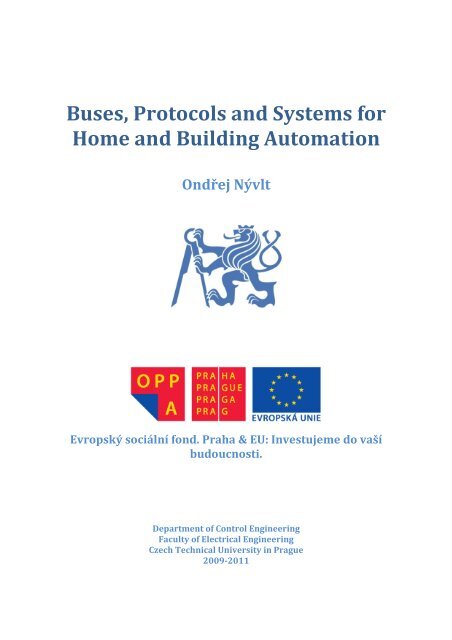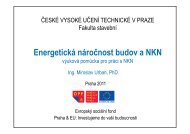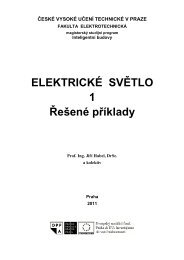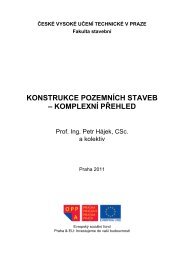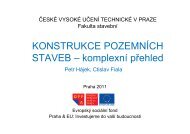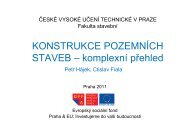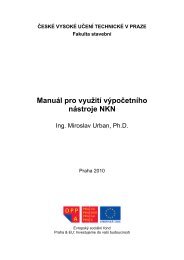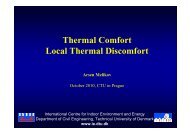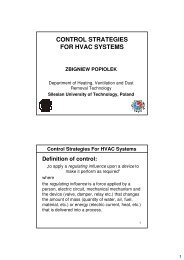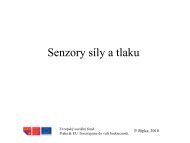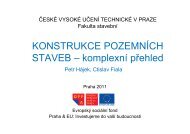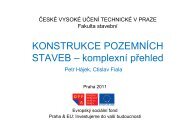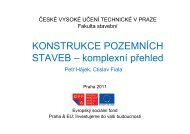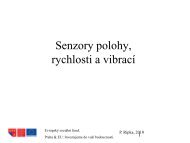Buses, Protocols and Systems for Home and Building Automation
Buses, Protocols and Systems for Home and Building Automation
Buses, Protocols and Systems for Home and Building Automation
Create successful ePaper yourself
Turn your PDF publications into a flip-book with our unique Google optimized e-Paper software.
<strong>Buses</strong>, <strong>Protocols</strong> <strong>and</strong> <strong>Systems</strong> <strong>for</strong><br />
<strong>Home</strong> <strong>and</strong> <strong>Building</strong> <strong>Automation</strong><br />
Ondřej Nývlt<br />
Evropský sociální fond. Praha & EU: Investujeme do vaší<br />
budoucnosti.<br />
Department of Control Engineering<br />
Faculty of Electrical Engineering<br />
Czech Technical University in Prague<br />
2009-2011
Evropský sociální fond. Praha & EU: Investujeme do vaší budoucnosti.<br />
Table of contents<br />
1. Basic categorization ......................................................................................................................... 3<br />
1.1. System openness ......................................................................................................................... 3<br />
1.2. System centralization .................................................................................................................. 4<br />
1.3. System complexity <strong>and</strong> versatility ............................................................................................... 5<br />
1.4. Physical layer – communication medium .................................................................................... 6<br />
2. Closed systems ................................................................................................................................ 7<br />
2.1. ABB Ego-N .................................................................................................................................... 7<br />
2.2. Elko EP iNels ................................................................................................................................ 8<br />
2.3. Eaton/Moeller X-Com<strong>for</strong>t <strong>and</strong> Nikobus ....................................................................................... 8<br />
3. Open st<strong>and</strong>ardized protocols ........................................................................................................ 11<br />
3.1. Complex protocols ..................................................................................................................... 12<br />
3.1.1. BacNet ................................................................................................................................... 12<br />
3.1.2. Konnexbus ............................................................................................................................. 14<br />
3.1.3. LonWorks <strong>and</strong> LonTalk .......................................................................................................... 16<br />
3.2. Specialized <strong>and</strong> other st<strong>and</strong>ardized protocols .......................................................................... 19<br />
3.2.1. DALI ....................................................................................................................................... 19<br />
3.2.2. DMX512 ................................................................................................................................. 23<br />
3.2.3. EnOcean ................................................................................................................................. 28<br />
3.2.4. M-Bus (Meter-Bus) ................................................................................................................ 31<br />
3.2.5. OpenTherm............................................................................................................................ 34<br />
3.2.6. SMI (St<strong>and</strong>ard Motor Interface) ............................................................................................ 38<br />
4. Other buses <strong>and</strong> systems used in home automation .................................................................... 42<br />
5. Bibliography ................................................................................................................................... 43<br />
Ondřej Nývlt - <strong>Buses</strong>, <strong>Protocols</strong> <strong>and</strong> <strong>Systems</strong> <strong>for</strong> <strong>Home</strong> <strong>and</strong> <strong>Building</strong> <strong>Automation</strong> 2
1. Basic categorization<br />
Evropský sociální fond. Praha & EU: Investujeme do vaší budoucnosti.<br />
<strong>Building</strong> automation systems <strong>and</strong> protocols can be divided into a plenty of categories using<br />
very different rules. In this wide set of classification properties we can determine some basic<br />
<strong>and</strong> interesting classifiers: openness, centralization or versatility of a system. These<br />
categories provide us important in<strong>for</strong>mation which is crucial in assessing usability of a<br />
protocol or a system <strong>for</strong> a project.<br />
1.1. System openness<br />
This property describes dependency of a system on a manufacturer. There exist two<br />
essential categories:<br />
• Open protocols (KNX, LON, BACnet, DALI, OpenTherm, EnOcean…)<br />
• Closed systems (Ego-n, iNels, Nikobus, XCom<strong>for</strong>t)<br />
Open protocols are based on open st<strong>and</strong>ards or open specifications, which are accessible <strong>for</strong><br />
everybody (who pay some fee) – not only <strong>for</strong> the manufacturer who developed the protocol.<br />
It is common that everything about the protocol is managed by a special association, not by<br />
the developer company. The most significant advantage of this approach is evident: open<br />
specification ensures a big flexibility <strong>for</strong> the building control system designer because there<br />
usually exist more than one manufacturer of a device with a desired function. Differences<br />
between devices are in a price, design or additional functions. Another advantage is that<br />
these protocols are supported by significant academic research producing new nontraditional<br />
features to the system (<strong>for</strong> example TU Wien is one of the leading research<br />
facilities <strong>for</strong> the KNX protocol). One of disadvantages of open protocols is usually the price of<br />
the system <strong>for</strong> family <strong>and</strong> small houses. These systems are cost-effective <strong>for</strong> bigger <strong>and</strong> large<br />
buildings, such as office buildings, hospitals, hotels or airports. Examples of some st<strong>and</strong>ards<br />
which cover the most important building automation protocols are KNX - EN 50090 <strong>and</strong><br />
ISO/IEC 14543, Lon - ANSI/CEA 709.1, BACnet – ASHRAE/ANSI 135 <strong>and</strong> ISO 16484-5.<br />
Specification (e.g. communication protocol) of a closed system is, in opposite to open<br />
protocols, not public to everyone – it is private to the developer company. There exist some<br />
exceptions – <strong>for</strong> example Eaton company <strong>and</strong> their Xcom<strong>for</strong>t system, where they offer the<br />
specification of their communication protocol in some cases to manufacturers who can add<br />
new features into their system. Closed building automation systems are closer to the end<br />
user than the open protocols – you can buy components (sensors <strong>and</strong> actors) of these<br />
systems in “supermarkets” like OBI, Hornbach or Baumax. The advantage are the prices of<br />
the components <strong>and</strong> of the whole system <strong>for</strong> family houses, flats or small houses. Usually<br />
these systems are very easy to install <strong>and</strong> to “program” (often without a computer). Closed<br />
systems are, in the most of cases, able to solve all the basic task of home automation. But<br />
they do not offer big versatility – a user can choose only from a very small group of devices<br />
<strong>and</strong> designs. Another problem is that users are dependent on one producer only <strong>and</strong> when<br />
the manufacturer stops the production of the devices, there will be a problem with the<br />
expansion of an installation <strong>and</strong> with replacement of crashed devices.<br />
Ondřej Nývlt - <strong>Buses</strong>, <strong>Protocols</strong> <strong>and</strong> <strong>Systems</strong> <strong>for</strong> <strong>Home</strong> <strong>and</strong> <strong>Building</strong> <strong>Automation</strong> 3
1.2. System centralization<br />
Evropský sociální fond. Praha & EU: Investujeme do vaší budoucnosti.<br />
Another property which divides protocols <strong>and</strong> systems into very different groups is logical or<br />
topology centralization:<br />
• Centralized systems (Ego-n, iNels, systems based on central PLC)<br />
• Decentralized/distributed systems (KNX, LON, Xcom<strong>for</strong>t…)<br />
• Hybrid systems (Nikobus)<br />
A centralized system (Fig. 1.2.1) has a central unit in the middle of the system (one or several<br />
units) which controls whole system functions. So the system does not need smart sensors<br />
<strong>and</strong> actors, but is very sensitive to a failure of the central unit. If it fails, then the whole<br />
system will not work. Today, these systems usually use a bus topology, but sometimes they<br />
still use direct connections to sensors <strong>and</strong> actors (a star topology – every device has its own<br />
connection with the central device).<br />
Fig. 1.2.1: Centralized system<br />
Distributed systems (Fig. 1.2.2) have no central unit. That means that every unit is<br />
intelligent/smart <strong>and</strong> knows what to do (e.g. when <strong>and</strong> where to send data). This is of<br />
course a big advantage, because the system is robust <strong>and</strong> more failsafe/reliable – when one<br />
unit fails, then the others work on. Distributed systems always use a bus topology (shared<br />
medium). The disadvantage is that the devices are more expensive than in the case of “dull”<br />
devices of a centralized system.<br />
Ondřej Nývlt - <strong>Buses</strong>, <strong>Protocols</strong> <strong>and</strong> <strong>Systems</strong> <strong>for</strong> <strong>Home</strong> <strong>and</strong> <strong>Building</strong> <strong>Automation</strong> 4
Evropský sociální fond. Praha & EU: Investujeme do vaší budoucnosti.<br />
Fig. 1.2.2: Distributed system<br />
Hybrid systems (Fig. 1.2.3) are somewhere in between – one example is Nikobus, where<br />
inputs (sensors) are connected using a bus <strong>and</strong> outputs (actors) are connected direct by<br />
using star topology to semi-central units.<br />
Fig. 1.2.3: Hybrid system<br />
1.3. System complexity <strong>and</strong> versatility<br />
This parameter represents the ability of a system to cover one or more control tasks in<br />
building <strong>and</strong> home automation:<br />
• Complex control system (KNX, LON, Xcom<strong>for</strong>t, Ego-n) are able to solve every basic<br />
task in building automation (<strong>for</strong> example HVAC 1 , lights, shutters/blinds, visualization<br />
or basic security)<br />
• System <strong>and</strong> protocols focused on one control task: e.g. DALI bus specialized on light<br />
control or OpenTherm focused on heating control<br />
1 Heating, Ventilating, <strong>and</strong> Air Conditioning<br />
Ondřej Nývlt - <strong>Buses</strong>, <strong>Protocols</strong> <strong>and</strong> <strong>Systems</strong> <strong>for</strong> <strong>Home</strong> <strong>and</strong> <strong>Building</strong> <strong>Automation</strong> 5
1.4. Physical layer – communication medium<br />
Evropský sociální fond. Praha & EU: Investujeme do vaší budoucnosti.<br />
St<strong>and</strong>ardized complex protocols usually offer more than one physical layer (up to 5 or 6),<br />
<strong>and</strong> commercial closed building control systems traditionally offer only one. This situation is<br />
changing today, because it is more <strong>and</strong> more common that a cheap commercial closed<br />
system offers, in addition to the communication by one of wired physical layers, also a<br />
wireless communication possibility.<br />
Here is a list of some typical physical layers used in building automation:<br />
• Twisted-pair/RS-485<br />
• Powerline 230V<br />
• Wireless – infrared, RF, ZigBee…<br />
• Ethernet<br />
• Coaxial cable<br />
Ondřej Nývlt - <strong>Buses</strong>, <strong>Protocols</strong> <strong>and</strong> <strong>Systems</strong> <strong>for</strong> <strong>Home</strong> <strong>and</strong> <strong>Building</strong> <strong>Automation</strong> 6
2. Closed systems<br />
Evropský sociální fond. Praha & EU: Investujeme do vaší budoucnosti.<br />
Closed building automation systems or proprietary systems are typically focused on family<br />
<strong>and</strong> small houses. There exit tens of these systems on the market today. They are developed<br />
not only by “no name” producers, but also by traditional companies like ABB or<br />
Moeller/Eaton. Components <strong>for</strong> these systems are often offered in hobby retail chains like<br />
OBI, Hornbach <strong>and</strong> Baumax, <strong>and</strong> in most cases they are cheaper than any system based on<br />
an open st<strong>and</strong>ard.<br />
Closed systems are usually complex, so they can solve all the basic tasks of home automation<br />
– HVAC, light <strong>and</strong> shutter/blinds control, remote control (PC, PDA, phone) <strong>and</strong> so on. A<br />
disadvantage is that they offer only very limited possibilities in functions, interconnections or<br />
designs of devices. An advantage of this kind of systems is that they often do not need any<br />
special training <strong>for</strong> installation <strong>and</strong> programming (often without PC, only using a<br />
screwdriver). We can find centralized, distributed <strong>and</strong> also hybrid closed systems.<br />
Closed systems are based on a proprietary communication protocol with wired (Nikobus) or<br />
wireless connection (Xcom<strong>for</strong>t, Conrad FS20 <strong>and</strong> <strong>Home</strong>Matic). Wireless closed systems are<br />
becoming very popular today because their price is comparable to the price of a wired<br />
solution with the advantage of easier installation (especially <strong>for</strong> older houses). Also more<br />
<strong>and</strong> more producers start to offer systems with both types of communication – wired <strong>and</strong><br />
wireless (iNels).<br />
2.1. ABB Ego-N<br />
Fig. 2.1.1: ABB Ego-n (1)<br />
Ego-n (2) is a centralized bus building automation system focused mainly on family houses. It<br />
has its origins in the Czech Republic. The bus is physically realized by a 4-core cable with 2<br />
cores <strong>for</strong> data <strong>and</strong> 2 cores <strong>for</strong> a power supply to the devices. There exist two types of buses<br />
(Fig. 2.1.2): primary (max 700m length) <strong>and</strong> secondary (max 2000m length). The primary bus<br />
connects sensors <strong>and</strong> actors (up to 64 devices on the bus) with a central control unit. The<br />
secondary bus is optional <strong>and</strong> it connects up to 8 central control units, a GSM unit, a unit of<br />
logic functions, a TCP/IP module <strong>and</strong> other high-end devices.<br />
Ondřej Nývlt - <strong>Buses</strong>, <strong>Protocols</strong> <strong>and</strong> <strong>Systems</strong> <strong>for</strong> <strong>Home</strong> <strong>and</strong> <strong>Building</strong> <strong>Automation</strong> 7
Evropský sociální fond. Praha & EU: Investujeme do vaší budoucnosti.<br />
Fig. 2.1.2: Ego-n Bus structure – translated <strong>and</strong> redrawn from (1)<br />
Ego-n can solve typical simple home automation tasks: HVAC, shutter/blinds <strong>and</strong> light<br />
control, motion detection, simulation of a presence of persons in the house, control over<br />
GSM, PC or PDA, fire <strong>and</strong> security alarms <strong>and</strong> so on. The configuration of the system can be<br />
done using a computer or by so-called “button mode” without a PC.<br />
2.2. Elko EP iNels<br />
Fig. 2.2.1: iNels (3)<br />
iNels is a typical fully centralized automation system based on the special central PLC-like<br />
unit CU2-01M or on the modular PLC Tecomat Foxtrot. This system is not focused only on<br />
family houses, but with a usage of the PLC Foxtrot also on BMS (building management<br />
systems) of large buildings. In the case of installation with CU2-01M (up to 192 connected<br />
I/O devices) in family houses, the system is capable to solve every typical task (e.g. HVAC,<br />
lights, shutters/blinds) plus some specialties, such as security <strong>and</strong> fire safety features, energy<br />
management, voice control, control over TV, PC or GSM. If PLC Foxtrot is used as the control<br />
unit, then the possibilities of the system are much wider (up to 288 connected I/O devices<br />
using 9 CIB) <strong>and</strong> of course much more expensive. iNels offers communication over its own<br />
bus called CIB (or over CAN). A new feature is a wireless connection of sensors <strong>and</strong> actors<br />
using protocol RFox. In the case of the PLC Foxtrot used as the central unit it is possible to<br />
communicate over protocols LON, BACnet, DALI, M-Bus, Profibus DP or Modbus.<br />
2.3. Eaton/Moeller X-Com<strong>for</strong>t <strong>and</strong> Nikobus<br />
Fig. 2.3.1: Nikobus<br />
Nikobus (4) is one of a few hybrid building automation systems (in topology). Inputs (up to<br />
256 sensors per one unit) are connected using a bus with central functional units (actor<br />
units), <strong>and</strong> end-devices like shutters/blinds, lights or heaters are connected directly to<br />
Ondřej Nývlt - <strong>Buses</strong>, <strong>Protocols</strong> <strong>and</strong> <strong>Systems</strong> <strong>for</strong> <strong>Home</strong> <strong>and</strong> <strong>Building</strong> <strong>Automation</strong> 8
Evropský sociální fond. Praha & EU: Investujeme do vaší budoucnosti.<br />
functional units (star topology) – Fig. 2.3.2. “Nikobus bus” is physically realized by a twistedpair<br />
<strong>and</strong> is used also as a power supply <strong>for</strong> sensors. Nikobus can take care of basic<br />
automation tasks, <strong>for</strong> example: light, HVAC <strong>and</strong> shutter/blinds control, switching of electric<br />
devices, security <strong>and</strong> alarms or energy management. Central functional units are not<br />
universal – these devices are specialized on some kind of tasks: a shutter/blinds unit, a<br />
dimming unit or a switching unit. These units have functions prepared inside, so users have<br />
to only configure them (by the computer or using the screwdriver). It is possible to<br />
incorporate RF components into the Nikobus system. Today the Nikobus is a little bit oldfashioned<br />
<strong>and</strong> not much adaptive system, but can be cost-effective <strong>for</strong> some basic, simple<br />
installations.<br />
Fig. 2.3.3: Nikobus topology – translated from (5)<br />
Fig. 2.3.4: X-Com<strong>for</strong>t<br />
Xcom<strong>for</strong>t (6) is an example of relatively cheap complex wireless solution <strong>for</strong> home<br />
automation (especially suitable <strong>for</strong> building reconstruction). The system is made of fully<br />
decentralized units communicating together using a proprietary wireless protocol (with a<br />
carrier frequency 868.3 MHz). Both actors <strong>and</strong> sensors (usually using batteries) are able to<br />
route packets, so if one device sends a message <strong>for</strong> a device which is not in the range of the<br />
Ondřej Nývlt - <strong>Buses</strong>, <strong>Protocols</strong> <strong>and</strong> <strong>Systems</strong> <strong>for</strong> <strong>Home</strong> <strong>and</strong> <strong>Building</strong> <strong>Automation</strong> 9
Evropský sociální fond. Praha & EU: Investujeme do vaší budoucnosti.<br />
transmitter, then other units in range are able to receive the message <strong>and</strong> send it to the next<br />
device until it reaches the desired device. The disadvantage is that the routing vector has to<br />
be preprogrammed to the devices (using the computer). Basic configuration of a simple<br />
installation (parameterization of predefined functions) can be done without the computer<br />
only by a screwdriver. This system is, as usual, capable to solve all the typical tasks of home<br />
automation, including basic remote visualization of the house on the computer/PDA or GSM<br />
control ability. The advantage of this product is that the producer (Moeller/Eaton) of the<br />
system offers other companies to share the communication protocol with them if they add<br />
some new interesting feature or device into the Xcom<strong>for</strong>t system. There are of course some<br />
disadvantages – <strong>for</strong> example the radiator valve needs external power supply (modern<br />
wireless valves use batteries – <strong>for</strong> example in the system made by Conrad).<br />
Ondřej Nývlt - <strong>Buses</strong>, <strong>Protocols</strong> <strong>and</strong> <strong>Systems</strong> <strong>for</strong> <strong>Home</strong> <strong>and</strong> <strong>Building</strong> <strong>Automation</strong> 10
3. Open st<strong>and</strong>ardized protocols<br />
Evropský sociální fond. Praha & EU: Investujeme do vaší budoucnosti.<br />
<strong>Protocols</strong> covered by some world-wide st<strong>and</strong>ards can be divided, according to the system<br />
complexity (Chapter 1.3), into two big groups: complex <strong>and</strong> specialized protocols.<br />
If we apply the well-known three-level hierarchical model of automation <strong>and</strong> control system<br />
on building automation protocols, we get a division shown in Fig. 3.1 <strong>and</strong> Fig. 3.2. Industrial<br />
control system theory traditionally describes these levels this way:<br />
- Field level - sensors, actuators <strong>and</strong> controllers<br />
- <strong>Automation</strong> (processing) level – execution <strong>and</strong> control systems (SCADA, HMI, MES or<br />
databases)<br />
- Management (in<strong>for</strong>mation) level – enterprise applications, ERP, SAP…<br />
KNX (Chapter 3.1.2) <strong>and</strong> LonMark (Chapter 3.1.3) are more field <strong>and</strong> automation level<br />
oriented (sensors, actors, higher control algorithms, monitoring, SCADA). BACnet (Chapter<br />
3.1.1) is, as opposite to these two protocols, more management level <strong>and</strong> less field level<br />
oriented. As we can see from the figure Fig. 3.2, single-purpose protocols are ranked in the<br />
field level.<br />
According to H. M. Newman from the Cornell University, Ithaca, USA, these three levels of<br />
building automation theory can be understood in a little bit different way (7):<br />
“The management level, <strong>for</strong> example, is where the majority of operator interface functions<br />
reside. Additional functions include communication with controllers, monitoring, alarm<br />
annunciation, trend logging <strong>and</strong> statistical analysis, centralized energy management<br />
functions, <strong>and</strong> communication with, or coordination of, dedicated non-HVAC systems such as<br />
fire alarm <strong>and</strong> security control. As a practical matter, most of the devices at this level are<br />
personal computer workstations.<br />
The automation level is where the majority of real-time control functions are carried out. The<br />
devices tend to be general-purpose, programmable controllers.<br />
The field-level contains the devices that connect to sensors <strong>and</strong> actuators. We would tend to<br />
think of field-level devices as unitary or application-specific controllers.”<br />
Fig. 3.1: The three level architecture <strong>and</strong> basic protocols (8)<br />
Ondřej Nývlt - <strong>Buses</strong>, <strong>Protocols</strong> <strong>and</strong> <strong>Systems</strong> <strong>for</strong> <strong>Home</strong> <strong>and</strong> <strong>Building</strong> <strong>Automation</strong> 11
3.1. Complex protocols<br />
Evropský sociální fond. Praha & EU: Investujeme do vaší budoucnosti.<br />
Fig. 3.2: St<strong>and</strong>ards in building automation (9)<br />
Complex st<strong>and</strong>ardized protocols are the most important section of building automation from<br />
the global point of view. Today, there exist millions of their applications from light control on<br />
an airport or in a city to the room control of luxury ships all over the world. St<strong>and</strong>ardized<br />
protocols are often supported by an academic research on one or more universities. The<br />
market consists of hundreds of manufacturers with thous<strong>and</strong>s of devices equipped with one<br />
of these protocols. In opposite to the systems based on the closed protocols (Chapter 2),<br />
systems presented in this chapter are used not only in family houses, but they offer also a<br />
sophisticated approach <strong>for</strong> a complex building management of large buildings (e.g. airports,<br />
hospitals, office buildings).<br />
There exists a lot of books in many languages about these famous building automation<br />
protocols. We can also find some usable books in the Czech language – <strong>for</strong> example<br />
“<strong>Building</strong> automation: communication systems with EIB/KNX, LON <strong>and</strong> BACnet” from the<br />
authors Hermann Merz, Thomas Hansemann <strong>and</strong> Christof Hübner (10) which practically<br />
shows basic principles of KNX, LonMark <strong>and</strong> BACNet. This is the reason why these three huge<br />
<strong>and</strong> important protocols will be described only briefly in this chapter.<br />
3.1.1. BacNet<br />
Fig. 3.1.1.1: BACnet<br />
The development of the BACnet protocol started in late eighties in the USA in the society<br />
called ASHRAE (American Society of Heating, Refrigerating <strong>and</strong> Air-Conditioning Engineers).<br />
From the beginning of its development, the protocol was designed only <strong>for</strong> the purposes of<br />
building automation, as its name suggests: A data communication protocol <strong>for</strong> <strong>Building</strong><br />
<strong>Automation</strong> <strong>and</strong> Control networks. Today, BACnet is covered by two st<strong>and</strong>ards: ISO 16484-5<br />
<strong>and</strong> ANSI/ASHRAE STANDARD 135. The protocol is very different from the other<br />
st<strong>and</strong>ardized protocols in one aspect: it is focused on the management <strong>and</strong> automation level<br />
Ondřej Nývlt - <strong>Buses</strong>, <strong>Protocols</strong> <strong>and</strong> <strong>Systems</strong> <strong>for</strong> <strong>Home</strong> <strong>and</strong> <strong>Building</strong> <strong>Automation</strong> 12
Evropský sociální fond. Praha & EU: Investujeme do vaší budoucnosti.<br />
in the above described hierarchical model (Fig. 3.1 <strong>and</strong> Fig. 3.2). This orientation is used<br />
mainly in non-residence buildings (BMS).<br />
The BACnet is an example of a completely non-proprietary object-oriented system. That<br />
means that there are no proprietary special chips needed (in opposite to LonTalk). On the<br />
two lowest levels of the ISO/OSI model, the protocol is very flexible, because we can<br />
presently choose from a very incompatible group of data link/physical layers including (Fig.<br />
3.1.1.2) ARCNET, Ethernet, BACnet/IP, Point-To-Point over RS-232, Master-Slave/Token-<br />
Passing over RS-485, LonTalk or KNX-IP.<br />
Fig. 3.1.1.2: BACnet protocol layers <strong>and</strong> equivalent ISO/OSI Layers (11)<br />
The in<strong>for</strong>mation exchange between devices over the BACnet is basically based on objects<br />
<strong>and</strong> services. Today, there exist 49 st<strong>and</strong>ard objects in the BACnet <strong>and</strong> every unit consists of<br />
at least one object – <strong>for</strong> example:<br />
- Device (m<strong>and</strong>atory <strong>for</strong> every BACnet device)<br />
- Analog input/output/value<br />
- Binary input/output/value<br />
- Schedule<br />
- Calendar<br />
- Program<br />
- File<br />
- Access Door<br />
- …<br />
Every object has some common properties like identifier, name or type <strong>and</strong> some special<br />
properties dependent on the type of the object. In the protocol, there are more than one<br />
hundred properties defined. Properties can be accessed, read or written by calling special<br />
services. The services (in total more than 30) are not made only <strong>for</strong> accessing the properties,<br />
in general, they can be described as follows: “Services are the means by which one BACnet<br />
device acquires in<strong>for</strong>mation from another device, comm<strong>and</strong>s another device to per<strong>for</strong>m some<br />
actions, or announces to one or more devices that some event has taken place. Each service<br />
request issued <strong>and</strong> service acknowledgment (reply) returned becomes a message packet<br />
transferred over the network from the sending to the receiving device.” (12)<br />
All these facts show us that besides traditional tasks of small <strong>and</strong> medium building<br />
automation (HVAC <strong>and</strong> light control), BACnet is able to take care about tasks of BMS <strong>and</strong><br />
complex building systems (e.g. security <strong>and</strong> fire safety systems, access control systems,<br />
vertical transport systems, elevator control, maintenance or waste management). Another<br />
Ondřej Nývlt - <strong>Buses</strong>, <strong>Protocols</strong> <strong>and</strong> <strong>Systems</strong> <strong>for</strong> <strong>Home</strong> <strong>and</strong> <strong>Building</strong> <strong>Automation</strong> 13
Evropský sociální fond. Praha & EU: Investujeme do vaší budoucnosti.<br />
important usage of the BACnet is an interconnection of incompatible building automation<br />
systems <strong>and</strong> components.<br />
First of disadvantages of the BACnet is that there exists no common configuration tool (in<br />
opposite to KNX <strong>for</strong> example). There<strong>for</strong>e almost every producer has to develop his own new<br />
tool <strong>for</strong> its devices. Another big problem with BACnet in recent history was that some<br />
BACnet products were not 100% compliant, so the interoperability of the devices was not as<br />
good as it should be. This problem was the reason of founding of BACnet Testing<br />
Laboratories (BTL).<br />
Today, BACnet is supported in devices of more than 500 companies <strong>and</strong> also universities<br />
(February 2011: 191 vendor ids in the USA, 59 in Germany, 4 in the Czech Republic) including<br />
Siemens, Honeywell, Hyundai, Mitsubishi, ABB, WAGO, DOMAT Control systems or Teco<br />
Kolín.<br />
Further reading:<br />
(8) (9) (11) (12)<br />
3.1.2. Konnexbus<br />
Fig. 3.1.2.1: KNX (13)<br />
Konnexbus (KNX) is the main building automation system (not only) in Europe. Eighty<br />
percent of companies on the market offer devices, which are capable to be connected into a<br />
KNX network. KNX is also known by its older name EIB Instabus. EIB is one of three older<br />
independent European building automation systems which were joined together in the year<br />
2001 to create a new system called KNX. The other systems were EHS <strong>and</strong> BatiBus <strong>and</strong> a<br />
backward compatibility to these older systems is provided. Konnexbus is covered by five<br />
st<strong>and</strong>ards today:<br />
- ISO/IEC 14543-3<br />
- CSA-ISO/IEC 14543-3 (Canada)<br />
- CENELEC EN 50090 (Europe)<br />
- CEN EN 13321-1 (Europe)<br />
- GB/Z 20965 (China)<br />
The KNX system is a typical example of a fully decentralized complex home <strong>and</strong> building<br />
automation system – every device has its own “intelligence” <strong>and</strong> knows what to<br />
receive/send from/to the bus <strong>and</strong> how to process the received data.<br />
As is usual in the case of st<strong>and</strong>ardized protocols, there exists an association (KNX association<br />
(13)) which cares about everything around the protocol – organizes a scientific conference<br />
every year, users meetings, trainings, publishes its own journal, develops <strong>and</strong> produces<br />
software <strong>for</strong> the users <strong>and</strong> manufactures... The KNX association has nowadays more than<br />
220 members including companies ABB, Gira, Schneider, Wago, Hager, Siemens, Buderus,<br />
Viessman, Somphy, Bosch or Toschiba. There also exist more than 30000 installer companies<br />
in 100 countries <strong>and</strong> 150 training centers all over the world. Strong academic research is<br />
very important <strong>for</strong> the KNX – the scientific club of the Konnexbus comprises about 60<br />
universities (<strong>for</strong> example prof. Kastner in TU Wien). These facts imply that customers can<br />
Ondřej Nývlt - <strong>Buses</strong>, <strong>Protocols</strong> <strong>and</strong> <strong>Systems</strong> <strong>for</strong> <strong>Home</strong> <strong>and</strong> <strong>Building</strong> <strong>Automation</strong> 14
Evropský sociální fond. Praha & EU: Investujeme do vaší budoucnosti.<br />
choose from a very large portfolio of KNX devices (more than 7000) which are the most<br />
suitable with a function, price <strong>and</strong> design <strong>for</strong> their project. Product lines include not only<br />
actors, sensors or visualization panels, but also gateways, which are capable to interconnect<br />
the KNX system with all other building automation systems (e.g. BACnet, LON, EnOcean,<br />
DALI, OpenTherm).<br />
The system can be used <strong>for</strong> automation of every type <strong>and</strong> size of a building – from family<br />
houses to office complexes <strong>and</strong> airports. A classical <strong>and</strong> basic application of the protocol is a<br />
sophisticated light control, but today it covers all main tasks in building automation: energy<br />
management; energy consumption measure; HVAC control (using KNX meteo-station);<br />
advanced shutter <strong>and</strong> jalousie control; control of electronic devices; security <strong>and</strong> safety<br />
tasks…<br />
Similarly to other typical complex st<strong>and</strong>ardized protocol KNX uses more than one physical<br />
layer:<br />
- Twisted pair wiring (inherited from the BatiBUS <strong>and</strong> EIB)<br />
- Powerline networking 230V (inherited from the EIB <strong>and</strong> EHS)<br />
- Wireless KNX-RF (carrier frequency 868.3 MHz)<br />
- Infrared<br />
- Ethernet (KNXnet/IP)<br />
The most frequently used medium is a twisted pair (called TP1) with a speed of 9600 bit/s,<br />
which enables an interconnection of basic sensors <strong>and</strong> actors (field level). TP1 is also used as<br />
a power supply <strong>for</strong> sensors. Ethernet physical layer is used mainly <strong>for</strong> a connection of<br />
“higher” devices (automation level) like gateways, touch-panels, computers or PLCs with the<br />
rest of the system.<br />
The communication itself is based on two types of addresses: individual <strong>and</strong> group address.<br />
Every device in a KNX net has a unique individual address. This address is used only <strong>for</strong><br />
programming, configuration <strong>and</strong> monitoring of the device – not <strong>for</strong> transferring process<br />
data. For this purpose, there are dedicated group addresses. This type of address is not<br />
bundled with a device, but with a “shared” variable of a specified type (we can also call them<br />
net-variables). This variable <strong>for</strong>ms the connection between sensors <strong>and</strong> actors, because it<br />
logically connects together a group of variables of the same type located in different devices.<br />
More than one device can listen to one group address <strong>and</strong> react on changes, but only one<br />
device can write data to the group address (1 producer <strong>and</strong> 1 or more consumers). So, <strong>for</strong><br />
example, when a push-button is pressed, then it sends a packet with some group address.<br />
Then a light actor, which is listening to this group address on the bus, recognizes the change<br />
of the variable <strong>and</strong> switches the light on. Important fact is that there is no packet sent<br />
directly (a packet with destination address equals to the individual address of the device)<br />
from the push-button to the actor.<br />
The KNX system can be configured <strong>and</strong> parameterized very easily. For this purpose, there<br />
exists a tool called Engineering Tool Software (ETS) which is manufacturer independent <strong>and</strong><br />
easy to learn. So the KNX system avoids typical problems of other st<strong>and</strong>ardized systems (e.g.<br />
BACnet) where exists a special configuration tool <strong>for</strong> every manufacturer quite often (you<br />
cannot use a tool from one producer <strong>for</strong> devices using the same protocol/bus from another<br />
producer). The ETS tool is managed by the KNX association <strong>and</strong> the manufacturers only have<br />
to add a plug-in into the ETS tool. This plug-in is designed <strong>for</strong> a detailed configuration of a<br />
device <strong>and</strong> its functions. The ETS tool exists in several modifications based on skills of a user.<br />
Of course, there are still some bugs in the ETS tool. If the possibilities of the<br />
Ondřej Nývlt - <strong>Buses</strong>, <strong>Protocols</strong> <strong>and</strong> <strong>Systems</strong> <strong>for</strong> <strong>Home</strong> <strong>and</strong> <strong>Building</strong> <strong>Automation</strong> 15
Evropský sociální fond. Praha & EU: Investujeme do vaší budoucnosti.<br />
parameterization are not complex enough <strong>for</strong> the installation purposes, then a PLC with a<br />
KNX interface can be connected into the system.<br />
First disadvantage of the KNX system is the price of the components <strong>for</strong> small installations<br />
(e.g. family houses). Second disadvantage is that the bus is designed only to transfer a small<br />
amount of data (the speed of TP1 which is the mainly used medium is only 9600 bit/s) of a<br />
special type, so it cannot be used <strong>for</strong> transferring <strong>and</strong> processing of a bigger stream of data,<br />
<strong>for</strong> example from a CCTV (as opposite to LonWorks protocol, where this is possible).<br />
Besides classical applications of the Konnexbus, we can find some interesting, huge or<br />
atypical installations like the Central Control of the Public Lighting System in the city of<br />
Salzburg (14), equipment of the Cruise Ship MS Belle de l’Adriatique (15) or BMS of Terminal<br />
5 Heathrow in London (together with DALI) (16).<br />
Further reading:<br />
(13) (17) (14) (15) (16)<br />
3.1.3. LonWorks <strong>and</strong> LonTalk<br />
Fig. 3.1.3.1: Lonworks (18)<br />
LonWorks is an automation plat<strong>for</strong>m with a st<strong>and</strong>ardized communication protocol called<br />
LonTalk developed in late nineties by the company Echelon. In opposite to the BACnet <strong>and</strong><br />
the KNX, LonWorks with LonTalk were not developed primarily <strong>for</strong> the purposes of building<br />
automation, but as a universal automation plat<strong>for</strong>m. LonWorks is a very flexible <strong>and</strong> complex<br />
automation system which is currently used not only <strong>for</strong> building automation, but we can find<br />
also some very successful applications in other fields of automation:<br />
- Train <strong>and</strong> subway control<br />
- Industrial production control<br />
- Petrol <strong>and</strong> gas stations control<br />
- Semiconductor manufacturing<br />
- Consumer appliance controls<br />
- Public street lighting, monitoring <strong>and</strong> control<br />
- Rail Electronically Controlled Pneumatic Braking<br />
LonTalk is, similarly to BACnet or KNX, supported by some international <strong>and</strong> national<br />
st<strong>and</strong>ards:<br />
- ISO/IEC 14908-1-4<br />
- ANSI/IEC 709.1-B. Control networking <strong>and</strong> home control<br />
- ANSI/ASHRAE 135-1995. MAC layer <strong>for</strong> the <strong>Building</strong> <strong>Automation</strong> <strong>and</strong> Control<br />
Networking st<strong>and</strong>ard<br />
- IEEE 1473-L. Intra-car <strong>and</strong> inter-car communications <strong>for</strong> rail vehicle (passenger trains)<br />
- AAR ECP. American Association of Railroads electronically controlled pneumatic<br />
braking systems<br />
- EN14908-1. European Union intelligent buildings<br />
- GB/Z 20177.1-2006. St<strong>and</strong>ardization Administration of China control networking<br />
Ondřej Nývlt - <strong>Buses</strong>, <strong>Protocols</strong> <strong>and</strong> <strong>Systems</strong> <strong>for</strong> <strong>Home</strong> <strong>and</strong> <strong>Building</strong> <strong>Automation</strong> 16
Evropský sociální fond. Praha & EU: Investujeme do vaší budoucnosti.<br />
- GB/T 20299.4-2006. St<strong>and</strong>ardization Administration of China Digital Technique<br />
Application of <strong>Building</strong> <strong>and</strong> Residence Community<br />
- SEMI E54.16. Semiconductor equipment manufacturers st<strong>and</strong>ard <strong>for</strong> sensor-actuator<br />
networks<br />
To support the protocol <strong>and</strong> the st<strong>and</strong>ards, an association called LonMark was founded. It<br />
has more than 400 members <strong>and</strong> it maintains the st<strong>and</strong>ards <strong>and</strong> the interoperability of<br />
devices. Besides companies like ABB, Honeywell, Thermokon, Shneider, Somfy or WAGO,<br />
LonWorks devices are also produced by Czech companies e.g. ZPA or ATD. Today, we can say<br />
that the plat<strong>for</strong>m is more popular in North America than in Europe, where the leader on the<br />
market of building automation is KNX.<br />
The LonWorks plat<strong>for</strong>m is focused mainly on the automation <strong>and</strong> field level of the<br />
hierarchical model. The system is based on a completely decentralized peer-to-peer net of<br />
smart nodes (Neuron chips). Every Neuron chip has a 48-bit unique serial number, which is<br />
very important <strong>for</strong> the identification in an installation. The dependency on a proprietary<br />
Neuron chip, which is the heart of every LonTalk device, is the most important disadvantage<br />
of the plat<strong>for</strong>m. This chip (developed with the companies Toschiba <strong>and</strong> Motorola) is based<br />
on three 8-bit processors, where two are dedicated <strong>for</strong> the protocol itself <strong>and</strong> the third one<br />
<strong>for</strong> the application:<br />
CPU1 – Medium Access Control<br />
CPU2 – Dedicated to processing Net variables<br />
CPU3 – User application programmed in a language called “Neuron C”<br />
The communication between nodes is realized by a logical linkage of network variables.<br />
Every device has a set of inputs, outputs <strong>and</strong> configuration network variables. These<br />
variables can only be of a type defined in the st<strong>and</strong>ard – the st<strong>and</strong>ardized types are called<br />
SNVT (St<strong>and</strong>ard Network Variable Types). Every SNVT contains some specific properties, e.g.<br />
upper/down limit. So, <strong>for</strong> example, if a thermostat wants to read a temperature from some<br />
sensor, then a virtual logical linkage between an output variable of the sensor <strong>and</strong> an input<br />
variable of the thermostat has to be created (the variables have to be of compatible type).<br />
One output variable can have a linkage with more than one input variable. This is a little bit<br />
different from the approach of the KNX, where the interconnection of input/output variables<br />
of devices is created by a group address of some st<strong>and</strong>ardized type. Measured values can be<br />
sent automatically in the case of some percentage change (analog variables), state change<br />
(binary variables), in some specified time intervals (using timer) or after some explicit<br />
request from another device.<br />
The LonTalk protocol can use one of six physical layers <strong>for</strong> transferring its data:<br />
- Twisted pair (common)<br />
- Power line 230V (common)<br />
- Radio frequency<br />
- Infrared<br />
- Coaxial cable<br />
- Fiber optics<br />
One of the newer features of Lon is LonTalk over IP or so-called IP-tunneling, which is very<br />
popular. There exists a special transceiver <strong>for</strong> every physical layer which is trans<strong>for</strong>ming<br />
physical layer specific signals to st<strong>and</strong>ardized input signals <strong>for</strong> the connected Neuron chip.<br />
The LonWorks plat<strong>for</strong>m can manage almost every task <strong>and</strong> wish in building <strong>and</strong> home<br />
automation (BMS) from room temperature control to security <strong>and</strong> access control systems.<br />
Ondřej Nývlt - <strong>Buses</strong>, <strong>Protocols</strong> <strong>and</strong> <strong>Systems</strong> <strong>for</strong> <strong>Home</strong> <strong>and</strong> <strong>Building</strong> <strong>Automation</strong> 17
Evropský sociální fond. Praha & EU: Investujeme do vaší budoucnosti.<br />
But because of the cost of devices, LonWorks (similarly to KNX) is still not much suitable <strong>for</strong><br />
“normal” family houses.<br />
Further reading:<br />
(19) (10) (20) (18)<br />
Ondřej Nývlt - <strong>Buses</strong>, <strong>Protocols</strong> <strong>and</strong> <strong>Systems</strong> <strong>for</strong> <strong>Home</strong> <strong>and</strong> <strong>Building</strong> <strong>Automation</strong> 18
Evropský sociální fond. Praha & EU: Investujeme do vaší budoucnosti.<br />
3.2. Specialized <strong>and</strong> other st<strong>and</strong>ardized protocols<br />
This chapter discusses a major part of important single-purpose st<strong>and</strong>ardized protocols in<br />
building automation (houses, discotheques, offices…). In addition to these protocols, we will<br />
also discuss the EnOcean protocol in this chapter, which is not single-purpose, but it is a little<br />
bit out of every category. <strong>Protocols</strong> presented here are often used by systems based on one<br />
of the complex protocols described in Chapter 3.1, or by a system with a programmable logic<br />
controller (PLC).<br />
Presented protocols:<br />
DALI – light control<br />
DMX512 – light <strong>and</strong> effects control <strong>for</strong> concerts, discotheques…<br />
EnOcean – general I/O<br />
M-bus – primary <strong>for</strong> remote reading of consumption meters<br />
OpenTherm – heating control<br />
SMI – drives <strong>and</strong> motors control (shutters)<br />
3.2.1. DALI<br />
Fig. 3.2.1.1: DALI (21)<br />
DALI<br />
DALI (Digital Addressable Lighting Interface) is a st<strong>and</strong>ardized bus <strong>and</strong> protocol <strong>for</strong><br />
controlling (switching <strong>and</strong> dimming) of light sources in a building. This protocol is intended as<br />
a replacement of classical light control possibilities, such as the analog 1-10V dimming or<br />
relay switching. DALI is based on the DSI (Digital Signal Interface) protocol, which is also a<br />
competitor to this solution.<br />
With this protocol, light sources can be switched <strong>and</strong> dimmed (a logarithmic dimming with<br />
the range 0.1-100 %), whole light-scenes can be defined <strong>and</strong> controlled. Another feature is a<br />
feedback from the bus <strong>and</strong> from every light, so it is possible to read-out a state of the ballast<br />
<strong>and</strong> possible errors.<br />
One DALI line supports:<br />
- Max 64 devices (masters + slaves)<br />
- Max 16 groups of devices – any slave can belong to as many as 16 groups<br />
- Max 16 light scenes<br />
Comm<strong>and</strong>s (e.g. power on/off, dimming, setting of a specific brightness) can be addressed to<br />
one device, to the whole group or to be broadcasted to every slave.<br />
Every ballast (slave) has configuration in<strong>for</strong>mation saved in its memory, which can be edited<br />
by a master, <strong>and</strong> consists of:<br />
- Address of a device<br />
- Group assignment of a device<br />
Ondřej Nývlt - <strong>Buses</strong>, <strong>Protocols</strong> <strong>and</strong> <strong>Systems</strong> <strong>for</strong> <strong>Home</strong> <strong>and</strong> <strong>Building</strong> <strong>Automation</strong> 19
Evropský sociální fond. Praha & EU: Investujeme do vaší budoucnosti.<br />
- Fade time <strong>and</strong> rate<br />
- Light levels (Power On, Maximum, System failure)<br />
- Values of brightness in assigned scenes<br />
Every slave device provides this feedback in<strong>for</strong>mation to the master:<br />
- Lamp/brightness state (on/off, brightness)<br />
- Lamp energy level<br />
- Lamp condition – failure<br />
Fig. 3.2.1.2: Example of a “free” DALI system installation (22)<br />
St<strong>and</strong>ards<br />
The DALI interface will be included in the international st<strong>and</strong>ard IEC 62386. Another<br />
st<strong>and</strong>ard which covers this topic is IEC 60929 (the fluorescent lamp ballast) under Annex E.<br />
DALI Action Group<br />
DALI AG is a working group of manufacturers <strong>and</strong> institutes which takes care of the DALI<br />
technology, defines technical principles <strong>and</strong> concepts of use, etc. DALI AG consists of more<br />
than 40 companies, <strong>for</strong> example: WAGO, ABB, Helvar, OSRAM, Philips Lighting, Tridonic<br />
ATCO or Zumbotel.<br />
A Master-slave system<br />
DALI is a strictly master-slave system, where slaves are light sources <strong>and</strong> masters are PLCs,<br />
PCs or sensors <strong>and</strong> switches. There are two possibilities of the master/slave DALI system:<br />
1) Single master (monomaster) system – only one master on the DALI line.<br />
2) Multi-master system – more than one device operates as a DALI master on one line<br />
(sensors, switches, PLCs…). These devices must follow some “traffic rules” to avoid<br />
data collision <strong>and</strong> to maintain the correct system function.<br />
Every master supports the monomaster system, but only newer master devices support<br />
multimaster systems.<br />
The basic principle is, that a master gets signals from sensors, or higher control systems, <strong>and</strong><br />
after processing this data, it creates <strong>and</strong> sends comm<strong>and</strong>s <strong>for</strong> slaves or groups of slaves (<strong>and</strong><br />
waits <strong>for</strong> possible answers with state in<strong>for</strong>mation). The possibility of the feedback is very<br />
beneficial with regard to the fact, that bulbs <strong>and</strong> lights get broken often.<br />
DALI system <strong>and</strong> a building management system (BMS)<br />
Ondřej Nývlt - <strong>Buses</strong>, <strong>Protocols</strong> <strong>and</strong> <strong>Systems</strong> <strong>for</strong> <strong>Home</strong> <strong>and</strong> <strong>Building</strong> <strong>Automation</strong> 20
Evropský sociální fond. Praha & EU: Investujeme do vaší budoucnosti.<br />
a) A completely st<strong>and</strong>-alone DALI system - Fig. 3.2.1.3. There is no connection with the<br />
BMS. All slaves are controlled by masters completely locally.<br />
Fig. 3.2.1.3: A st<strong>and</strong>-alone DALI system (22)<br />
b) A st<strong>and</strong>-alone subsystem - Fig. 3.2.1.4. A DALI system is connected to the BMS, but<br />
sensors/switches of the DALI system are connected directly to the DALI control units<br />
or to the DALI line. Only in<strong>for</strong>mation about faults, states <strong>and</strong> most important<br />
comm<strong>and</strong>s (central on/off) is communicated between the DALI system <strong>and</strong> the BMS.<br />
There<strong>for</strong>e, most of the comm<strong>and</strong>s are issued locally (from DALI area – Fig. 3.2.1.4).<br />
The DALI system is not dependent on the BMS <strong>and</strong> it can work correctly without a<br />
BMS.<br />
Fig. 3.2.1.4: DALI as a st<strong>and</strong>-alone subsystem of the BMS (22)<br />
c) A pure subsystem of BMS - Fig. 3.2.1.5. A DALI system is fully dependent on the BMS<br />
– all comm<strong>and</strong>s come from the BMS through the DALI/BMS gateway (= DALI master).<br />
That means that without the BMS, the DALI system does not work. From these three<br />
possibilities, this one is the most frequent solution.<br />
Ondřej Nývlt - <strong>Buses</strong>, <strong>Protocols</strong> <strong>and</strong> <strong>Systems</strong> <strong>for</strong> <strong>Home</strong> <strong>and</strong> <strong>Building</strong> <strong>Automation</strong> 21
Evropský sociální fond. Praha & EU: Investujeme do vaší budoucnosti.<br />
Fig. 3.2.1.5: DALI system like a pure subsystem of the BMS (22)<br />
Bus - parameters<br />
A DALI line is a two-wire (polarity non-sensitive = non-polarized) line with max 300 meters<br />
length (the maximal voltage drop is 2 V), which consists of up to 64 devices. There are no<br />
special wiring requirements due to the low transmission rate, <strong>and</strong> the line also does not<br />
need to be terminated by any resistor. The topology of the system is absolutely free (line,<br />
star, tree, ring) <strong>and</strong> the bus is powered by the voltage 9.5-22.4 V (usually 16 V). Maximal<br />
transmission speed is 1200 b/s. DALI uses Manchester encoding, <strong>and</strong> together with its high<br />
SNR, this bus is very robust <strong>and</strong> “foolproof”. Maximal current input of 250 mA is allowed on<br />
the DALI line <strong>and</strong> each device may consume a maximum of 2 mA. The low level on bus is 0 V<br />
(-4.5 V to +4.5 V) <strong>and</strong> the high level is 16 V (9.5 V to 22.5 V).<br />
Fig. 3.2.1.6: Topology possibilities of the DALI system (22)<br />
Ondřej Nývlt - <strong>Buses</strong>, <strong>Protocols</strong> <strong>and</strong> <strong>Systems</strong> <strong>for</strong> <strong>Home</strong> <strong>and</strong> <strong>Building</strong> <strong>Automation</strong> 22
Evropský sociální fond. Praha & EU: Investujeme do vaší budoucnosti.<br />
Advantages<br />
- Easy modification – no need of rewiring in case of a change<br />
- Energy savings – 30-60 % through dimming lights in response to actual brightness of<br />
natural light <strong>and</strong> switching by occupancy sensors.<br />
- More com<strong>for</strong>table lighting (scenes, individual control…)<br />
- Automatic identification of failed lamps <strong>and</strong> ballasts<br />
- Robustness, an interference free operation<br />
Disadvantages<br />
From the point of view of today’s state-of-the-art, DALI is a little bit “archaic” system, which<br />
should be upgraded (new specification 3.0 should come in near future). DALI cannot be used<br />
<strong>for</strong> controlling fast changes of brightness because of its very slow communication speed<br />
1200 b/s. Another disadvantage is a high price of devices, which are equipped with DALI.<br />
A lot of DALI master units still support only a single-master system. Maximal length of the<br />
line is 300 meters <strong>and</strong> only 64 devices can be connected. Also adding more than one sensor<br />
or switch directly into the DALI bus is not easy, because they have to support the multimaster<br />
structure. So an easier way how to solve this problem is to keep the sensors separate<br />
from DALI line <strong>and</strong> send comm<strong>and</strong>s through a central controller (Fig. 3.2.1.5). Moreover, the<br />
market offer of DALI sensors is not very wide.<br />
Interconnections<br />
There exist a gateway to almost every important building <strong>and</strong> home automation system, bus<br />
or protocol: Modbus, DMX512, KNX, BacNet (Loytec), LON or Xcom<strong>for</strong>t/Nikobus. Another<br />
possible option of interconnection is a modular PLC used as an Ethernet gateway <strong>for</strong> DALI or<br />
to connect DALI with EnOcean <strong>and</strong> other protocols.<br />
Future (autumn 2009)<br />
Because DALI is today “a little bit archaic”, but relatively often used system <strong>for</strong> controlling<br />
lights, there should come some new specification of the DALI bus soon, with new<br />
improvements. Besides a new specification, the WAGO Company is preparing (release in 2<br />
years) a new master PLC card, which will support the multi-master DALI.<br />
Further reading:<br />
(21) (22) (23) (24)<br />
3.2.2. DMX512<br />
DMX512 is a simple serial st<strong>and</strong>ard protocol designed especially <strong>for</strong> controlling light sources<br />
(dimmers <strong>and</strong> other light effects in theaters, discotheques…). DMX512 was developed in the<br />
year 1986 by the institute USITT (United States Institute <strong>for</strong> Theatre Technology) <strong>and</strong><br />
updated in the year 1990. The purpose of the developing DMX512 was the same as in the<br />
case of DALI – to replace old-fashioned analog 1-10 V dimming, which has problems with<br />
interference <strong>and</strong> every device has to have its own wires connected to a controller (a star<br />
topology).<br />
Ondřej Nývlt - <strong>Buses</strong>, <strong>Protocols</strong> <strong>and</strong> <strong>Systems</strong> <strong>for</strong> <strong>Home</strong> <strong>and</strong> <strong>Building</strong> <strong>Automation</strong> 23
Evropský sociální fond. Praha & EU: Investujeme do vaší budoucnosti.<br />
A basic principle of this protocol is very simple: a master periodically sends a packet of 512<br />
bytes containing comm<strong>and</strong>s <strong>for</strong> slaves over the RS-485 line. That means that DMX512 is a<br />
master-slave system without a feedback from slaves (light sources) to the master<br />
(controller), <strong>and</strong> without an automatic error checking or correction. We call this type of<br />
communication a simplex (one-way) communication.<br />
A physical layer<br />
DMX512 uses the RS-485 (EIA-485) st<strong>and</strong>ard <strong>for</strong> communication. So a DMX152 line (a<br />
segment) is made of twisted-pair wires <strong>and</strong> has to be terminated with a resistor with a value<br />
120 Ω (a terminator). The maximal length of the DMX512 cable is 1,200 m (3,900 ft.). A<br />
number of segments is not limited. St<strong>and</strong>ard connectors <strong>for</strong> DMX512 are with 5 or 3 pins, i.e.<br />
XLR style microphone connectors. Originally, there was used only the 5 pin connector with 2<br />
twisted pairs (the first pair is used <strong>for</strong> DMX512 data <strong>and</strong> the second pair can be freely used<br />
by a manufacturer). Now 3 pin connectors are commonly used with only 1 twister pair<br />
reserved only <strong>for</strong> DMX data. The pin out <strong>for</strong> the 5-pin <strong>and</strong> 3-pin connector is showed in Tab.<br />
3.2.2.1 <strong>and</strong> on Fig. 3.2.2.1 <strong>and</strong> Fig. 3.2.2.2.<br />
Tab. 3.2.2.1: Pin out of DMX512 connectors<br />
Pin 3-pin XLR 5-pin XLR<br />
1 Ground/shield<br />
2 Data 1 - (first TP - DMX data)<br />
3 Data 1 + (first TP - DMX data)<br />
4 - Data 2 - (second TP)<br />
5 - Data 2 + (second TP)<br />
Fig. 3.2.2.1: Pin out of 5-pin XLR (25)<br />
Fig. 3.2.2.2: Pin out of 3-pin XLR (26)<br />
Networking<br />
DMX512 devices are connected using a daisy-chain method. Every device has a DMX512 “in”<br />
connector <strong>and</strong> often a DMX512 “out” or “thru” connector. A DMX controller has only<br />
DMX512 “out” connector. Devices at the end of the segment have to have the terminator in<br />
“out” connector placed (i.e. the resistor 120 Ω between pins 2 <strong>and</strong> 3). Some of the devices<br />
Ondřej Nývlt - <strong>Buses</strong>, <strong>Protocols</strong> <strong>and</strong> <strong>Systems</strong> <strong>for</strong> <strong>Home</strong> <strong>and</strong> <strong>Building</strong> <strong>Automation</strong> 24
Evropský sociální fond. Praha & EU: Investujeme do vaší budoucnosti.<br />
have built-in software-operated terminator. A basic connection is showed in the Fig. 3.2.2.3.<br />
On one DMX512 line (RS-845), up to the 32 devices can be connected. When splitters <strong>and</strong><br />
repeaters are used, then more devices can be placed in a DMX512 system.<br />
Fig. 3.2.2.3: A basic DMX512 system (27)<br />
Fig. 3.2.2.4: More complex DMX512 system (27)<br />
Data <strong>for</strong>mat<br />
Data (in the little endian <strong>for</strong>mat) transmission is serial <strong>and</strong> asynchronous with a speed of<br />
250 kb/s. A DMX512’s data packet consists of up to 512 data bytes carrying comm<strong>and</strong>s <strong>for</strong><br />
devices without an address. There is no need of transmitting addresses through a DMX512<br />
packet because every device (slave) knows his own base address (0-511).<br />
From this address, every slave reads his data (one or more bytes with a meaning of a<br />
comm<strong>and</strong>) <strong>and</strong> reacts on them (e.g. set brightness on a specified level). There can be more<br />
Ondřej Nývlt - <strong>Buses</strong>, <strong>Protocols</strong> <strong>and</strong> <strong>Systems</strong> <strong>for</strong> <strong>Home</strong> <strong>and</strong> <strong>Building</strong> <strong>Automation</strong> 25
Evropský sociální fond. Praha & EU: Investujeme do vaší budoucnosti.<br />
devices with the same base address. These devices will react on the same data/comm<strong>and</strong>, so<br />
they are controlled as a group.<br />
A data packet (Fig. 3.2.2.5) starts with the zero level (min 88 ms on the receiver side) called<br />
reset (break) followed by high level called MAB (Mark after break) taking at least 8 ms on the<br />
receiver side. By these two first parts, the transmission is synchronized. The first data frame<br />
called start code takes place after break <strong>and</strong> MAB. Then up to 512 data frames are<br />
transmitted, where every frame consists of 1 start bit, 8 data bits (without parity) <strong>and</strong> 2 stop<br />
bits. Between 2 frames, there could be a timeout MTBF (Mark Time Between Frames) with<br />
maximal length of 1 second. At the end of a packet, a timeout MTBP (Mark Time Between<br />
Packets) is placed with max length of 1 second. If there appears any level (high or low) on<br />
the line <strong>for</strong> more than 1 second, then this situation is evaluated as a loss of the signal (error),<br />
which is a dangerous situation.<br />
Fig. 3.2.2.5: Composition of the DMX512 data packet (28)<br />
Ondřej Nývlt - <strong>Buses</strong>, <strong>Protocols</strong> <strong>and</strong> <strong>Systems</strong> <strong>for</strong> <strong>Home</strong> <strong>and</strong> <strong>Building</strong> <strong>Automation</strong> 26
Evropský sociální fond. Praha & EU: Investujeme do vaší budoucnosti.<br />
Tab. 3.2.2.2: Parts <strong>and</strong> lengths of the DMX512 data packet (28)<br />
Transmitter Receiver<br />
min max min max<br />
1.<br />
Break - reset 92 μs - 88 μs -<br />
2. Mark after Break (MAB) 12 μs 1 s 8 μs 1 s<br />
3. Slot Time - - - -<br />
4. Start bit - - - -<br />
5. Least Significant Data Bit (LSB) - - - -<br />
6. Most Significant Data Bit (MSB) - - - -<br />
7. Stop Bit - - - -<br />
8. Stop bit - - - -<br />
9. Mark Time between Slots 0 s 1 s 0 s 1 s<br />
10. Mark be<strong>for</strong>e Break (MBB) 0 s 1 s 0 s 1 s<br />
11. Break to Break time 1203 μs 1 s 1196 μs 1,25 s<br />
12. Reset Sequence (Break, MAB, Start Code) - - - -<br />
13. DMX512 Packet 1204 μs 1 s 1196 μs 1,25 s<br />
14. Start Code (SLOT 0 Data) - - - -<br />
15. Slot 1 Data - - - -<br />
16. Slot n Data ( Max. 512) - - - -<br />
With the transmission speed 250 kb/s, every bit lasts 4 µs, so data frame’s length (11 bits) is<br />
44 µs. If we have 512 data frames, then a data packet with a break <strong>and</strong> MAB lasts:<br />
Break + MAB + (1 + 512)*frame = min 88 + min 8 + 513*44 = min 22668 µs<br />
So the highest frequency of the data packet sending is about 44,12 Hz = 44 updates/second.<br />
Application of the protocol<br />
- Dimmers<br />
- Mirror positioning<br />
- Gobo positioning<br />
- Gelstring positioning<br />
- Shutter positioning<br />
- Focus motor positioning<br />
- Fog <strong>and</strong> smoke machines<br />
- …<br />
Because there is no error checking, DMX cannot be used <strong>for</strong> pyrotechnics or laser control<br />
<strong>and</strong> other safety-problematical applications.<br />
St<strong>and</strong>ard<br />
In the year 2004, DMX512 st<strong>and</strong>ardized by ANSI under the st<strong>and</strong>ard “E1.11-2004, USITT<br />
DMX512–A”.<br />
Ondřej Nývlt - <strong>Buses</strong>, <strong>Protocols</strong> <strong>and</strong> <strong>Systems</strong> <strong>for</strong> <strong>Home</strong> <strong>and</strong> <strong>Building</strong> <strong>Automation</strong> 27
Evropský sociální fond. Praha & EU: Investujeme do vaší budoucnosti.<br />
Remote Device Management (29)<br />
The disadvantage of the simplex communication of DMX512 was eliminated in the year 2006<br />
(approved by ANSI) with an enhancement of the DMX512 protocol called Remote Device<br />
Management (RDM). RDM allow bi-directional communication between a light source <strong>and</strong> a<br />
controller over st<strong>and</strong>ard DMX512 line. Devices that support RDM can be placed on the same<br />
line with devices that do not support it – operation of these devices is not disturbed (RDM<br />
has a different start code). So this enhancement allows DMX512 to manage <strong>and</strong> configure<br />
devices or process a status monitoring. RDM has three basic communication types – unicast,<br />
broadcast <strong>and</strong> discovery.<br />
Art-Net (30)<br />
Art-Net is an Ethernet based protocol <strong>for</strong> transporting DMX512 data. This protocol is also<br />
supported by over 20 manufacturers <strong>and</strong> also by the Wireshark software.<br />
Further reading:<br />
(25) (26) (27) (28) (29) (31) (30) (32) (33) (34) (35) (36) (37)<br />
3.2.3. EnOcean<br />
Fig. 3.2.3.1: EnOcean (38)<br />
EnOcean (38) is an example of the modern popular completely wireless “green” technology.<br />
EnOcean is a system of a distributed intelligence based on a communication between<br />
wireless intelligent sensors <strong>and</strong> actuators (every node has its own processor/microcontroller,<br />
so it can make its own decisions). This system is often used only as an I/O subsystem (a<br />
building fieldbus) <strong>for</strong> a larger building automation system.<br />
Advantages of an EnOcean technology:<br />
a) Wireless communication<br />
b) Smart energy management with a low consumption of energy<br />
c) Innovative energy harvesting<br />
d) A lot of service-free/maintenance-free battery-free nodes<br />
e) Reduced fire risk, inductive fields <strong>and</strong> low electromagnetic pollution<br />
The disadvantages of the system are on the first place prices of devices equipped with this<br />
protocol, relatively small group of offered products, <strong>and</strong> especially in the Czech Republic, the<br />
low availability of the products on the market.<br />
An alliance<br />
The EnOcean Alliance was founded in the year 2001 as a spin-off company of Siemens AG,<br />
who created this technology. EnOcean Alliance contains nowadays more than 100<br />
integration partners (Siemens, WAGO, Osram, Steute, Thermokon, VIPA, Phoenix Contact…),<br />
which offer more than 300 products with the EnOcean technology. There exist a lot of<br />
Ondřej Nývlt - <strong>Buses</strong>, <strong>Protocols</strong> <strong>and</strong> <strong>Systems</strong> <strong>for</strong> <strong>Home</strong> <strong>and</strong> <strong>Building</strong> <strong>Automation</strong> 28
Evropský sociální fond. Praha & EU: Investujeme do vaší budoucnosti.<br />
interfaces <strong>and</strong> gateways <strong>for</strong> its interconnection with buses such as KNX, LON or with TCP/IP<br />
<strong>and</strong> communication modules into PLC.<br />
Nodes<br />
There are 3 types of nodes – transmit only (wireless sensors), receive only (actuators,<br />
gateways) <strong>and</strong> bidirectional (wireless sensors, wireless actuators, gateways, repeaters)<br />
nodes. Nodes can be harvester powered (sensors, actuators), battery powered (sensors,<br />
actuators) or line powered (actuators, sensors, gateways, repeaters). A lot of modules<br />
(mainly sensors) are service-free <strong>and</strong> self-powered (without battery), so they use some kind<br />
of energy from the surrounding environment with an optimal energy consumption<br />
management. Every self-powered sensor contains an energy harvester <strong>and</strong> converter.<br />
Fig. 3.2.3.2: Example of a control system based on the EnOcean (38)<br />
Types of energy harvesters <strong>for</strong> battery-less nodes:<br />
a) Motion converter – gains energy from switching operations/button motions<br />
(piezoelectric crystal de<strong>for</strong>mation). Service-free <strong>for</strong> 50,000 switching cycles.<br />
b) Solar cells – used <strong>for</strong> example <strong>for</strong> a window monitoring<br />
c) Thermal converter – heat dissipation is used as an energy source (Peltier element)<br />
d) Rotation converter – used <strong>for</strong> example <strong>for</strong> monitoring of car wheels<br />
e) Vibration converter – used in industry<br />
Fig. 3.2.3.3: Principal structure of the EnOcean sensor node (38)<br />
Ondřej Nývlt - <strong>Buses</strong>, <strong>Protocols</strong> <strong>and</strong> <strong>Systems</strong> <strong>for</strong> <strong>Home</strong> <strong>and</strong> <strong>Building</strong> <strong>Automation</strong> 29
Evropský sociální fond. Praha & EU: Investujeme do vaší budoucnosti.<br />
Wireless technology<br />
EnOcean modules use two frequencies: 868.3 MHz <strong>for</strong> Europe <strong>and</strong> 315 MHz <strong>for</strong> North<br />
America <strong>and</strong> other non-FCC countries.<br />
Technical parameters (Europe):<br />
a) License-free 868.3 MHz with 1% duty cycle with ASK modulation (<strong>for</strong> example KNX RF<br />
implementation uses 868.3 MHz with 1% <strong>and</strong> FSK modulation)<br />
b) Data packets consist of 14 bytes, where 4 bytes are data (39). For example, to push a<br />
button means to send 3 packets. These 3 packets are sent at pseudo-r<strong>and</strong>om<br />
intervals reducing the possibility of packet collisions.<br />
c) Range: 30 m inside buildings <strong>and</strong> 300 meters in free field. For range extension,<br />
repeaters can be used.<br />
d) Signal duration is approximately 1 ms<br />
e) Speed: 125 kbit/s<br />
f) No interference with WLAN or other wireless systems<br />
g) Every device has a 32-bit unique serial identification number<br />
h) 50 µWs is a minimal energy that is needed <strong>for</strong> sending packets<br />
Application of the EnOcean technology<br />
The EnOcean technology is mainly used in a home <strong>and</strong> building automation, where it is an<br />
ideal solution <strong>for</strong> a building reconstruction. The technology is able to solve some “classical”<br />
tasks of the building control:<br />
a) Lighting<br />
b) Shading<br />
c) Presence detection<br />
d) Window monitoring<br />
e) Room temperature sensing<br />
f) Measured data acquisition<br />
But buildings are not the only possible usage of this system. The EnOcean technology can be<br />
well used <strong>for</strong> example in cars, where the combination of the wireless communication <strong>and</strong> of<br />
a battery-free solution harvesting the energy from a rotation motion is ideal <strong>for</strong> wheels<br />
monitoring. Another interesting application is an audience voting system developed by the<br />
EnOcean's UK distributor (40). In this system, each member of the audience receives a fourbutton<br />
remote control (Fig. 3.2.3.4) with an EnOcean transmitter which has a unique<br />
identification number. The signals from the controllers are then decoded by a receiver<br />
connected to a PC. Other examples of the usage of EnOcean are listed in (41).<br />
Further reading:<br />
(38) (39) (40) (42)<br />
Fig. 3.2.3.4: EnOcean Voting System (40)<br />
Ondřej Nývlt - <strong>Buses</strong>, <strong>Protocols</strong> <strong>and</strong> <strong>Systems</strong> <strong>for</strong> <strong>Home</strong> <strong>and</strong> <strong>Building</strong> <strong>Automation</strong> 30
3.2.4. M-Bus (Meter-Bus)<br />
Evropský sociální fond. Praha & EU: Investujeme do vaší budoucnosti.<br />
Fig. 3.2.4.1: M-Bus (43)<br />
M-Bus is the first communication protocol primarily designed <strong>for</strong> remote reading of<br />
consumption meters (water, heat, electricity or gas). This protocol can be used in industry,<br />
as well as in building automation. Meter-Bus was developed by Dr. Horst Ziegler of the<br />
University of Paderborn in cooperation with Texas Instruments Deutschl<strong>and</strong> GmbH <strong>and</strong><br />
Techem GmbH (actual version is 4.8). The usage of the M-bus <strong>and</strong> the requirements <strong>for</strong> the<br />
protocol are very different from the other systems presented here: the protocol offers failsafe<br />
data collecting from consumption meters on a long distance with a very low speed,<br />
which is the effect of the robust, disturbance non-sensitive communication (the same<br />
approach as the DALI bus (3.2.1)).<br />
Today, M-Bus is strongly supported by traditional automation companies like Siemens<br />
(DESIGO), WAGO or ABB, <strong>and</strong> also by a lot of smaller companies, which are, besides sensors,<br />
usually selling gateways <strong>for</strong> every important communication bus.<br />
Wired M-Bus<br />
The basic wired version of the M-Bus has a physical, link (both covered by the st<strong>and</strong>ard EN<br />
13757-2) <strong>and</strong> application layer (EN 13757-3) implemented. This basic version can have up to<br />
250 slaves connected to the master by the bus. If this amount is not enough, then the<br />
network layer can be implemented. M-Bus is a serial bus with 8-bit asynchronous half-duplex<br />
communication equipped by two basic communication mechanisms: request/response <strong>and</strong><br />
acknowledged communication.<br />
The communication itself is based on the master-slave model where the master unit is also<br />
called a Repeater. In the wired version, the master unit starts the communication <strong>and</strong> asks<br />
slaves <strong>for</strong> measurements. The advantage is that the slaves can be powered directly by the<br />
bus instead of batteries. The wired bus is a physically shielded twisted-pair <strong>and</strong> the distance<br />
between two devices can be up to 1000 meters (with max speed 300 bauds). The highest<br />
speed of the communication through the wired M-Bus is 9600 bauds when the distance<br />
between two devices is no longer than 350 meters.<br />
The exchange of data is similar to the OpenTherm technology (3.2.5): The master is changing<br />
the voltage when it sends the data (log.1 = 36 V <strong>and</strong> log.0 = 24 V) <strong>and</strong> slaves are responding<br />
by the change of the current on the bus (log.1 = 1.5 mA <strong>and</strong> log.0 is represented by<br />
consumption higher by 11 to 20 mA than in the case of log.1). There exist four types of<br />
frames which are traveling between master <strong>and</strong> slaves: Single Character, Short Frame,<br />
Control Frame <strong>and</strong> Long Frame.<br />
There exist also a lot of converters <strong>and</strong> gateways which are interconnecting M-Bus with<br />
other protocols <strong>and</strong> buses, e.g. M-Bus to Modbus, M-Bus to IP/Ethernet or M-Bus to KNX. In<br />
Fig. 3.2.4.2 <strong>and</strong> Fig. 3.2.4.3 an example of an Ethernet gateway is depicted, equipped by a<br />
webserver, SNMP, XML, Syslog, Modbus/TCP <strong>and</strong> automatic graph generating.<br />
Ondřej Nývlt - <strong>Buses</strong>, <strong>Protocols</strong> <strong>and</strong> <strong>Systems</strong> <strong>for</strong> <strong>Home</strong> <strong>and</strong> <strong>Building</strong> <strong>Automation</strong> 31
Evropský sociální fond. Praha & EU: Investujeme do vaší budoucnosti.<br />
Fig. 3.2.4.2: An example of an Ethernet gateway (44)<br />
Fig. 3.2.4.3: Connection of the Ethernet gateway (44)<br />
Fig. 3.2.4.4: Wireless M-Bus (45)<br />
Wireless M-Bus<br />
The newest approach (year 2007) in the protocol is Wireless M-Bus (st<strong>and</strong>ard EN 13757-4)<br />
developed by a Norwegian company Radiocrafts AS. This new feature uses a frequency 868<br />
Ondřej Nývlt - <strong>Buses</strong>, <strong>Protocols</strong> <strong>and</strong> <strong>Systems</strong> <strong>for</strong> <strong>Home</strong> <strong>and</strong> <strong>Building</strong> <strong>Automation</strong> 32
Evropský sociální fond. Praha & EU: Investujeme do vaší budoucnosti.<br />
MHz with a max speed from 4.8 kb/s to 100 kb/s. Wireless M-Bus has the same application<br />
layer as the wired version but it has its own physical <strong>and</strong> link layer.<br />
Fig. 3.2.4.5: Radiocrafts AS Wireless M-Bus (45)<br />
One of the most important differences between the wired <strong>and</strong> wireless version is, that in the<br />
wireless approach, the master is not initiating the communication. The master is now only a<br />
collector or a concentrator of measurements, <strong>and</strong> the meters themself start periodically the<br />
communication <strong>and</strong> send him the measurements. The reason <strong>for</strong> this approach is the need<br />
of low energy consumption, because the devices are usually powered by batteries. The<br />
device is usually in the sleep mode, where it saves the battery (the battery then can power<br />
the device up to 20 years). After the predefined interval, a timer wakes the device up <strong>and</strong> it<br />
sends the measurement to the master.<br />
Fig. 3.2.4.6: Basic principles of the Wireless M-Bus (45)<br />
Ondřej Nývlt - <strong>Buses</strong>, <strong>Protocols</strong> <strong>and</strong> <strong>Systems</strong> <strong>for</strong> <strong>Home</strong> <strong>and</strong> <strong>Building</strong> <strong>Automation</strong> 33
Evropský sociální fond. Praha & EU: Investujeme do vaší budoucnosti.<br />
This solution can be used <strong>for</strong> a lot of interesting applications: <strong>for</strong> example <strong>for</strong> a realization of<br />
a reading of water consumption meters in houses from a car – the car is going through the<br />
street <strong>and</strong> wirelessly reads the meters, so there is no need of personal visit to the house.<br />
Further reading:<br />
(43) (46) (47) (48) (49) (45)<br />
3.2.5. OpenTherm<br />
Fig. 3.2.4.7: An example of the usage of the Wireless M-Bus (45)<br />
Fig. 3.2.5.1: OpenTherm (50)<br />
OpenTherm (50) is a manufacturer-independent protocol <strong>for</strong> communication in HVAC <strong>and</strong><br />
heating systems. OpenTherm products are typically room thermostats, heating control units,<br />
boilers, air heaters, programmers, weather compensators or cascade controllers. It is an<br />
open st<strong>and</strong>ard, which specification is available to all members (<strong>and</strong> also <strong>for</strong> non-members)<br />
of the OpenTherm Association. The OpenTherm protocol was <strong>for</strong> the first time specified <strong>for</strong><br />
the first time in the year 1996 by the company Honeywell. Later, this company sold the<br />
specification <strong>for</strong> one British Pound. The reason <strong>for</strong> creating this protocol was a need to have<br />
a st<strong>and</strong>ardized <strong>and</strong> simple-to-use communication between thermostats <strong>and</strong> boilers.<br />
The non-profit OpenTherm Association has more than 40 member companies today (year<br />
2008 – 42 companies), <strong>for</strong> example: Viessmann, Hager Controls SAS, Honeywell, Siemens<br />
<strong>Building</strong> Technologies…<br />
Communication<br />
The basic principle is that a thermostat or a room-unit calculates a heating dem<strong>and</strong> <strong>and</strong><br />
transmits it to a boiler or a heater. Then the boiler answers with his status <strong>and</strong> with other<br />
in<strong>for</strong>mation <strong>for</strong> diagnostics. OpenTherm uses 2-wire non-polarity sensitive physical layer,<br />
where the cable is used not only <strong>for</strong> the communication between master <strong>and</strong> slave, but also<br />
<strong>for</strong> powering the master. The maximum length of the wiring is 50 meters. In communication,<br />
the master changes voltage level when transmitting data, <strong>and</strong> the slave changes current<br />
when answering to the master. Used levels of the current <strong>and</strong> the voltage are:<br />
Current:<br />
- high signal 17….23 mA<br />
- low signal 5….9 mA<br />
Ondřej Nývlt - <strong>Buses</strong>, <strong>Protocols</strong> <strong>and</strong> <strong>Systems</strong> <strong>for</strong> <strong>Home</strong> <strong>and</strong> <strong>Building</strong> <strong>Automation</strong> 34
- Threshold 11.5….14.5 mA<br />
Voltage:<br />
- high signal 15….18 V<br />
- low signal ………7 V max<br />
- Threshold 9.5….12.5 V<br />
Rise <strong>and</strong> fall times: 50 μs max<br />
Evropský sociální fond. Praha & EU: Investujeme do vaší budoucnosti.<br />
Fig. 3.2.5.2: Current/voltage levels in an OpenTherm communication (51)<br />
OpenTherm is not exactly a bus system, because the communication can be only “point-topoint”<br />
or “multipoint-to-point”:<br />
a) An older type of the communication is “point-to-point” (Fig. 3.2.5.3) which means 1<br />
master (controller/thermostat) communicating with 1 slave (boiler).<br />
Fig. 3.2.5.3: Point-to-point communication (51)<br />
b) In June 2008, a new specification version 3.0 came, which brought two innovations:<br />
“Smart power” <strong>and</strong> “multi-point to point” (Fig. 3.2.5.4 <strong>and</strong> Fig. 3.2.5.5)<br />
communication. This means one slave can be controlled by one or more masters. The<br />
heart of this new feature is a special device called “Gateway”, which is placed<br />
between masters <strong>and</strong> a slave (Fig. 3.2.5.4).<br />
Ondřej Nývlt - <strong>Buses</strong>, <strong>Protocols</strong> <strong>and</strong> <strong>Systems</strong> <strong>for</strong> <strong>Home</strong> <strong>and</strong> <strong>Building</strong> <strong>Automation</strong> 35
Evropský sociální fond. Praha & EU: Investujeme do vaší budoucnosti.<br />
Fig. 3.2.5.4: Multipoint-to-point communication (51)<br />
Fig. 3.2.5.5: Multi-point to point Opentherm communication (52)<br />
A master (a thermostat) is in an OpenTherm system powered from a slave (a boiler).<br />
With the new feature from the specification 3.0 called “Smart power”, power<br />
consumption can be smartly managed by asking the slave <strong>for</strong> providing more or less<br />
power according to the needs of the master (e.g. backlight on). The minimal available<br />
power is 35 mW. The other two power levels available to the master are: 136 mW<br />
(medium power) <strong>and</strong> 255 mW (high power).<br />
There are two implementations of the OpenTherm protocol:<br />
a) An older analog implementation called OpenTherm/light (OT/-), which offers a very<br />
limited functionality. A master generates a PWM signal which is representing the<br />
desired temperature of the boiler water (a set point). In the case of short circuiting of<br />
the OpenTherm connection, the boiler stars to heat the water. The current signal<br />
from the boiler indicates its status: “error” <strong>and</strong> “no error”. OT/- is not a much usable<br />
implementation <strong>and</strong> due to its restrictions <strong>and</strong> limited possibilities is not used often.<br />
b) The full implementation of the protocol is called OpenTherm/plus (OT/+). OT/+ is, in<br />
contrast to the analog OT/-, a digital implementation. That means that no PWM<br />
signal is generated <strong>and</strong> communication is realized by packet sending. Devices which<br />
are supporting both implementations detect automatically after reset which protocol<br />
is used by a partner-side. The OT/+ protocol uses Manchester encoded<br />
Ondřej Nývlt - <strong>Buses</strong>, <strong>Protocols</strong> <strong>and</strong> <strong>Systems</strong> <strong>for</strong> <strong>Home</strong> <strong>and</strong> <strong>Building</strong> <strong>Automation</strong> 36
Evropský sociální fond. Praha & EU: Investujeme do vaší budoucnosti.<br />
(synchronization can be done every bit) unidirectional serial communication with a<br />
transmission rate of 1.0 kHz <strong>and</strong> data frame (Fig. 3.2.5.6) consisting of 34 bits (a startbit,<br />
32 data bits, a stop-bit). The data bits consist of:<br />
- 1 parity-bit (even)<br />
- 3 message type bits = used <strong>for</strong> an identification of the content <strong>and</strong> meaning of<br />
the frame (read-data, write-data, data-invalid…)<br />
- 4 spare bits<br />
- 8 data-ID bits, which identify uniquely the transmitted values. These bits are<br />
called OpenTherm-ID. There are 256 OT-ID available: 128 of them are reserved<br />
<strong>for</strong> OEM use, <strong>and</strong> the other 90 are functionally specified.<br />
- 16 data-Value bits<br />
In normal operation, a master sends a frame every second. Answer from a slave is<br />
expected in 20ms – 800 ms. After a slave answers, there is a 100 ms pause.<br />
Fig. 3.2.5.6: OpenTherm frame structure (51)<br />
There exist only few st<strong>and</strong>ard interfaces <strong>for</strong> interconnection of the OpenTherm system with<br />
BACnet IP, LON, Modbus, WWW (Fig. 3.2.5.7) or KNX (Fig. 3.2.5.8).<br />
Fig. 3.2.5.7: A gateway to other systems (53)<br />
Ondřej Nývlt - <strong>Buses</strong>, <strong>Protocols</strong> <strong>and</strong> <strong>Systems</strong> <strong>for</strong> <strong>Home</strong> <strong>and</strong> <strong>Building</strong> <strong>Automation</strong> 37
Evropský sociální fond. Praha & EU: Investujeme do vaší budoucnosti.<br />
Fig. 3.2.5.8: KNX <strong>and</strong> OpenTherm (54)<br />
Advantages of OpenTherm:<br />
a) OpenTherm can use existing 2-wires cables, which were used <strong>for</strong> example <strong>for</strong> an old<br />
thermostat<br />
b) No polarity sensitive wiring<br />
c) No use of batteries – a master powered from a slave<br />
d) An open st<strong>and</strong>ard – devices from different companies can work together<br />
e) Offers com<strong>for</strong>table controlling of a HVAC application (e.g. shows more details about<br />
state of the boiler on a display of the thermostat).<br />
Further reading:<br />
(50) (51) (52) (53) (54) (55) (56) (57)<br />
3.2.6. SMI (St<strong>and</strong>ard Motor Interface)<br />
Fig. 3.2.6.1: SMI (58)<br />
St<strong>and</strong>ard Motor Interface (SMI) is one of the newest specialized fieldbuses <strong>for</strong> home <strong>and</strong><br />
building automation. The history of this protocol started in the year 2001, when the SMI<br />
Working Group was founded. The reason <strong>for</strong> developing this bus was dissatisfaction with a<br />
st<strong>and</strong>ard way of controlling drives in a building:<br />
- No intelligent operating (not possible to move to an exact position…)<br />
- No feedback from drives about their position <strong>and</strong> about their state<br />
Ondřej Nývlt - <strong>Buses</strong>, <strong>Protocols</strong> <strong>and</strong> <strong>Systems</strong> <strong>for</strong> <strong>Home</strong> <strong>and</strong> <strong>Building</strong> <strong>Automation</strong> 38
- Very complex cabling<br />
SMI tries to find solutions <strong>for</strong> these problems.<br />
Evropský sociální fond. Praha & EU: Investujeme do vaší budoucnosti.<br />
Fig. 3.2.6.2: A basic SMI concept (58)<br />
St<strong>and</strong>ard Motor Interface is a typical monomaster-multislave system where one master is<br />
able to control up to 16 slaves (drives). Slaves can be addressed individually or together<br />
(group addressing or broadcast messages) – the allocation of one address per one drive is<br />
possible, but is not necessary if all the drives are to be controlled together.<br />
There are two types of comm<strong>and</strong>s transferred through SMI – st<strong>and</strong>ard comm<strong>and</strong>s <strong>and</strong><br />
manufacturer-specific comm<strong>and</strong>s. Comm<strong>and</strong>s offer, besides basic actions (e.g. move up,<br />
move down), more complicated <strong>and</strong> complex actions, <strong>for</strong> example precise movement to<br />
intermediate position or request <strong>for</strong> diagnostic/feedback messages (possible responses: a<br />
motor is rotating, direction of the rotation, a motor defect, an actual position). Diagnostic<br />
response is also possible to be read during the drive rotation.<br />
SMI Applications<br />
SMI is specialized only in the intelligent digital operation of drives in buildings. The typical<br />
applications are:<br />
- roller shutters<br />
- sun protection systems<br />
- venetian blind drives<br />
- awning<br />
- solar-operated systems<br />
- swimming pool covers<br />
- winter gardens<br />
- smoke <strong>and</strong> fire protection<br />
- …<br />
SMI drives can be operated by control units, which can be completely st<strong>and</strong>-alone (Fig.<br />
3.2.6.3) or are connected to higher building automation systems like KNX or LON <strong>for</strong><br />
example (Fig. 3.2.6.4).<br />
Ondřej Nývlt - <strong>Buses</strong>, <strong>Protocols</strong> <strong>and</strong> <strong>Systems</strong> <strong>for</strong> <strong>Home</strong> <strong>and</strong> <strong>Building</strong> <strong>Automation</strong> 39
Evropský sociální fond. Praha & EU: Investujeme do vaší budoucnosti.<br />
Fig. 3.2.6.3: <strong>Home</strong> automation <strong>and</strong> SMI (58)<br />
Fig. 3.2.6.4: SMI <strong>and</strong> BMS (58)<br />
Communication<br />
SMI uses a 5-wire cable (Fig. 3.2.6.5) <strong>for</strong> the interconnection of the units: three wires are <strong>for</strong><br />
the power supply (L, N, PE) <strong>and</strong> the last two wires are reserved <strong>for</strong> the data transfer.<br />
Maximal length of the cable is up to 350 m with free topology. Data transfer is bi-directional<br />
with a speed 2400 Bit/s.<br />
Fig. 3.2.6.5: SMI cable (58)<br />
Ondřej Nývlt - <strong>Buses</strong>, <strong>Protocols</strong> <strong>and</strong> <strong>Systems</strong> <strong>for</strong> <strong>Home</strong> <strong>and</strong> <strong>Building</strong> <strong>Automation</strong> 40
Evropský sociální fond. Praha & EU: Investujeme do vaší budoucnosti.<br />
Fig. 3.2.6.6: SMI cabling <strong>and</strong> basic concept (58)<br />
SMI Group<br />
SMI Group is today (autumn 2009) much smaller than <strong>for</strong> example the OpenTherm<br />
Association, DALI Group or EnOcean Alliance, but is still growing. Group consists of 7 base<br />
members (Becker Antriebe GmbH, elero GmbH, Griesser Electronic AG, SELVE GmbH & Co.<br />
KG <strong>and</strong> Alcatel-Lucent Deutschl<strong>and</strong> AG), which own the br<strong>and</strong> <strong>and</strong> finance the SMI<br />
development. Then there are 11 SMI Partners (license holders – <strong>for</strong> example ABB, WAGO,<br />
Insta…), which are producing <strong>and</strong> selling SMI compatible drives <strong>and</strong> control units. The last<br />
part of the SMI Group is SMI Supporters, which are supporting the development of the SMI<br />
(4 companies).<br />
One of interesting applications of the SMI protocol is a sun protection system in the new<br />
opera building in Oslo based on SMI drives.<br />
Further reading:<br />
(58) (59)<br />
Ondřej Nývlt - <strong>Buses</strong>, <strong>Protocols</strong> <strong>and</strong> <strong>Systems</strong> <strong>for</strong> <strong>Home</strong> <strong>and</strong> <strong>Building</strong> <strong>Automation</strong> 41
Evropský sociální fond. Praha & EU: Investujeme do vaší budoucnosti.<br />
4. Other buses <strong>and</strong> systems used in home automation<br />
There is a lot of other buses, protocols <strong>and</strong> systems that are used in the building automation<br />
<strong>and</strong> in BMS but they are not much wide spread or their usage in buildings is not a typical<br />
application – some examples include:<br />
- Well known open st<strong>and</strong>ardized protocol CAN (Control Area Network). CAN has a lot<br />
of applications in car or train automation, industrial automation <strong>and</strong> also some in the<br />
building automation (Moniko Tower in Zürich)….<br />
- BMS Local Control Network (LCN) - http://www.lcn-america.com/<br />
- Zumbotel Luxmate – a system <strong>for</strong> light management, which is using DSI (Digital Signal<br />
Interface) <strong>and</strong> DALI www.luxmate.com<br />
- MP-Bus – a bus designed by the company Belimo <strong>for</strong> a master/slave communication<br />
with valves<br />
- I 2 C – protocol used typically <strong>for</strong> sensors in robotics<br />
- ZigBee – universal wireless mesh network<br />
- CEBus - Consumer Electronics Bus<br />
- C-Bus<br />
- oBIX - Open <strong>Building</strong> In<strong>for</strong>mation Exchange is a st<strong>and</strong>ard <strong>for</strong> Web Services-based<br />
interfaces to building control systems (60)<br />
- DyNet<br />
- UPB – Universal Powerline Bus<br />
- X10 – a open st<strong>and</strong>ard <strong>for</strong> a communication of home automation devices<br />
- INSTEON<br />
- …<br />
Ondřej Nývlt - <strong>Buses</strong>, <strong>Protocols</strong> <strong>and</strong> <strong>Systems</strong> <strong>for</strong> <strong>Home</strong> <strong>and</strong> <strong>Building</strong> <strong>Automation</strong> 42
5. Bibliography<br />
Evropský sociální fond. Praha & EU: Investujeme do vaší budoucnosti.<br />
1. Žabka, Miroslav. ABB: Inteligentní elektroinstalace Ego-n. Elektrika.cz. [Online] [Cited: February 18,<br />
2011.] http://elektrika.cz/data/clanky/abb-inteligentni-elektroinstalace-ego-nae/view.<br />
2. ABB s.r.o., Elektro-Praga. Ego-n. ABB. [Online] [Cited: February 18, 2011.]<br />
http://www117.abb.com/index.asp?thema=9745.<br />
3. Elko EP. iNels. iNels. [Online] [Cited: February 18, 2011.] www.inels.cz.<br />
4. Bothe, Robert. Inteligentní elektroinstalace budov - systém Nikobus, Uživatelský manuál v.1.0.<br />
Eaton elektrotechnika. [Online] [Cited: February 18, 2011.]<br />
http://www.eatonelektrotechnika.cz/pdf/manual%20nikobus.pdf.<br />
5. TES. Chytrý dům. Testování energetických systémů. [Online] [Cited: April 04, 2011.]<br />
http://www.tesnet.cz/cs/produkty-chytrydum.php.<br />
6. Eaton. Xcom<strong>for</strong>t. Xcom<strong>for</strong>t. [Online] [Cited: February 21, 2011.] www.xcom<strong>for</strong>t.cz,<br />
www.xcom<strong>for</strong>t.com.<br />
7. NEWMAN, H. MICHAEL. BACnet Goes to Europe . . . <strong>and</strong> Beyond. BACnet.org. [Online] 1998.<br />
[Cited: February 24, 2011.] http://www.bacnet.org/Bibliography/HPAC-10-98.html.<br />
8. BACnet Interest Group Europe. BACnet Basics. BACnet Interest Group Europe. [Online] [Cited:<br />
February 23, 2011.] http://www.big-eu.org/eng/bacnet/basics.php.<br />
9. Wolfgang Granzer, Wolfgang Kastner, Christian Reinisch. Gateway-free Integration of BACnet <strong>and</strong><br />
KNX using Multi-Protocol Devices. Vienna : Vienna University of Technology, <strong>Automation</strong> <strong>Systems</strong><br />
Group, 2008.<br />
10. Hermann Merz, Thomas Hansemann, Christof Hübner. Automatizované systémy budov. Praha :<br />
Grada Publishing, a.s., 2009. 978-80-247-2367-9.<br />
11. ICT TU Wien. About BACnet. BACnet. [Online] [Cited: February 25, 2011.]<br />
http://www.ict.tuwien.ac.at/bacnet/.<br />
12. Swan, Bill. The Language of BACnet-Objects, Properties <strong>and</strong> Services. BACnet.org. [Online] [Cited:<br />
February 25, 2011.] http://www.bacnet.org/Bibliography/ES-7-96/ES-7-96.htm.<br />
13. KNX Association. KNX. KNX. [Online] [Cited: February 22, 2011.]<br />
14. KNX. Central Control of the Public Lighting System with KNX. KNX.org. [Online] [Cited: February<br />
23, 2011.] http://www.knx.org/fileadmin/downloads/02%20-%20What%20is%20KNX/03%20-<br />
%20KNX%20Award%20Projects/KNX%20Award%20Projects%202008/S%20-<br />
%20KNX%20Award%202008%20-%20Special2%20EN.pdf.<br />
15. —. Cruise Ship MS Belle de l’Adriatique. KNX.org. [Online] [Cited: February 23, 2011.]<br />
http://www.knx.org/fileadmin/downloads/02%20-%20What%20is%20KNX/03%20-<br />
Ondřej Nývlt - <strong>Buses</strong>, <strong>Protocols</strong> <strong>and</strong> <strong>Systems</strong> <strong>for</strong> <strong>Home</strong> <strong>and</strong> <strong>Building</strong> <strong>Automation</strong> 43
Evropský sociální fond. Praha & EU: Investujeme do vaší budoucnosti.<br />
%20KNX%20Award%20Projects/KNX%20Award%20Projects%202008/S%20-<br />
%20KNX%20Award%202008%20-%20Special%20EN.pdf.<br />
16. —. Terminal 5 Heathrow in London. KNX.org. [Online] [Cited: February 23, 2011.]<br />
http://www.knx.org/fileadmin/downloads/02%20-%20What%20is%20KNX/03%20-<br />
%20KNX%20Award%20Projects/KNX%20Award%20Projects%202006/english_commercial_Androme<br />
da%20Telematics.PDF.<br />
17. Wikipedia EN. KNX. Wikipedia. [Online] [Cited: february 22, 2011.]<br />
http://en.wikipedia.org/wiki/KNX_(st<strong>and</strong>ard).<br />
18. Echelon. LonWorks Technology Overview. Echelon. [Online] [Cited: February 23, 2011.]<br />
http://www.echelon.com/communities/developers/lonworks/.<br />
19. Wikipedia EN. LonWorks. Wikipedia EN. [Online] [Cited: February 23, 2011.]<br />
http://en.wikipedia.org/wiki/LonWorks.<br />
20. Galbavý, Martin. Vizualizace a vzdálené řízení v síti LonWorks. Bachelor thesis. Prague : FEE CTU<br />
in Prague, 2006.<br />
21. DALI AG. DALI. [Online] [Cited: June 17, 2009.] http://www.dali-ag.org/.<br />
22. Advance. The ABC's of DALI. [Online] [Cited: June 17, 2009.]<br />
http://www.advancetrans<strong>for</strong>mer.com/uploads/resources/CO-7110-R01_ABCofDALI.pdf.<br />
23. Wikipedia EN. DALI. [Online] [Cited: June 17, 2009.]<br />
http://en.wikipedia.org/wiki/Digital_Addressable_Lighting_Interface.<br />
24. Resi. User manual RESI-DALI-MODBUS Converter. [Online] [Cited: June 17, 2009.]<br />
http://www.marcomweb.it/Documenti/DALI_MODBUS.pdf.<br />
25. Baldwin, Tom. 5 pin XLR. [Online] [Cited: June 17, 2009.]<br />
freespace.virgin.net/tom.baldwin/pinout-5xlr.html.<br />
26. Baldwin, Tom. 3 pin XLR. [Online] [Cited: June 17, 2009.]<br />
http://freespace.virgin.net/tom.baldwin/pinout-3xlr.html.<br />
27. Doug Fleenor Design Inc. DMX 512 A Simple Explanation. [Online] [Cited: June 17, 2009.]<br />
www.dfd.com/dmxbasic.html.<br />
28. Rol, Erwin. DMX512. [Online] [Cited: June 17, 2009.]<br />
www.erwinrol.com/index.php?stagecraft/dmx.php.<br />
29. Wikipedia EN. RDM. [Online] [Cited: June 17, 2009.] http://en.wikipedia.org/wiki/RDM_(lighting).<br />
30. Rol, Erwin. Art-Net. [Online] [Cited: June 17, 2009.]<br />
http://www.erwinrol.com/index.php?stagecraft/artnet.php.<br />
31. USITT. DMX512. [Online] [Cited: June 17, 2009.] http://www.usitt.org/st<strong>and</strong>ards/DMX512.html.<br />
Ondřej Nývlt - <strong>Buses</strong>, <strong>Protocols</strong> <strong>and</strong> <strong>Systems</strong> <strong>for</strong> <strong>Home</strong> <strong>and</strong> <strong>Building</strong> <strong>Automation</strong> 44
32. MCUserver. Anatomie DMX152. [Online] [Cited: June 17, 2009.]<br />
http://www.mcu.cz/print.php?news.81.<br />
Evropský sociální fond. Praha & EU: Investujeme do vaší budoucnosti.<br />
33. Kar, Ujjal. DMX512 EQUIPMENT. [Online] [Cited: June 17, 2009.] http://www.dmx512online.com/equpt.html.<br />
34. Kar, Ujjal. The DMX512 Packet. [Online] [Cited: June 17, 2009.] http://www.dmx512online.com/packt.html.<br />
35. Pangolin Laser <strong>Systems</strong>. About DMX512. [Online] [Cited: June 17, 2009.]<br />
http://www.pangolin.com/LD2000/dmx-about.htm.<br />
36. Wikipedia CS. DMX512. [Online] [Cited: June 17, 2009.] http://cs.wikipedia.org/wiki/DMX512.<br />
37. Nušl, Jaroslav. Protokol DMX512. [Online] [Cited: June 17, 2009.]<br />
http://dmx512.svetla.org/theory.htm.<br />
38. EnOcean. EnOcean - Self-powered Wireless Sensors. [Online] [Cited: May 12, 2009.]<br />
http://www.enocean.com/.<br />
39. Wikipedia EN. EnOcean. [Online] [Cited: May 12, 2009.] http://en.wikipedia.org/wiki/EnOcean.<br />
40. TDC. EnOcean Voting <strong>and</strong> Quiz Scoring System. TDC. [Online] [Cited: May 12, 2009.]<br />
http://www.tdc.co.uk/index.php?key=voting.<br />
41. EnOcean. Case Studies. [Online] [Cited: May 12, 2009.] http://www.enocean.com/en/casestudies/.<br />
42. Technik.ihned.cz. I nepatrná energie se dá efektivně využít. Odpady - Odpadové hospodářství,<br />
ekonomika životního prostředí. [Online] 3 25, 2005. [Cited: May 4, 2009.]<br />
http://odpady.ihned.cz/?secpart=_clanek_fchec_ih_.<br />
43. M-Bus Usergroup. M-Bus Usergroup. [Online] [Cited: August 27, 2009.] www.m-bus.com.<br />
44. HWgroup. HWg-PWR: M-Bus IP měřič energie (SNMP, WEB). HWgroup. [Online] [Cited: March<br />
28, 2011.] http://www.hw-group.com/products/HWg-PWR/hwg-pwr_cz.html.<br />
45. Vojáček, Antonín. Sběrnice Wireless M-BUS - jde to i bezdrátově... Automatizace.HW.cz. [Online]<br />
[Cited: March 28, 2011.] http://automatizace.hw.cz/sbernice-wireless-mbus-jde-i-bezdratove.<br />
46. Kocourek, Petr <strong>and</strong> Novák, Jiří. M- Bus: Popis funkce. [Online] [Cited: August 26, 2009.]<br />
http://fieldbus.feld.cvut.cz/mbus/mbus.html.<br />
47. Wikipedia EN. Meter-Bus. Wikipedia. [Online] [Cited: March 28, 2011.]<br />
http://en.wikipedia.org/wiki/Meter-Bus.<br />
48. Wikipedia CZ. M-Bus. Wikipedia. [Online] [Cited: March 28, 2011.]<br />
http://cs.wikipedia.org/wiki/M-Bus.<br />
Ondřej Nývlt - <strong>Buses</strong>, <strong>Protocols</strong> <strong>and</strong> <strong>Systems</strong> <strong>for</strong> <strong>Home</strong> <strong>and</strong> <strong>Building</strong> <strong>Automation</strong> 45
Evropský sociální fond. Praha & EU: Investujeme do vaší budoucnosti.<br />
49. Vojáček, Antonín. M-BUS (Meter-Bus) - základní popis komunikačního protokolu.<br />
Automatizace.hw.cz. [Online] [Cited: March 28, 2011.] http://automatizace.hw.cz/mbus-meterbuszakladni-popis-komunikacniho-modelu.<br />
50. OpenTherm Association. OpenTherm Association. OpenTherm. [Online] [Cited: May 19, 2009.]<br />
http://www.opentherm.eu.<br />
51. NEC. 78K0 Series - OpenTherm Data Link Layer Implementation. [Online] [Cited: June 17, 2009.]<br />
http://www.eu.necel.com/_pdf/U17475EE1V0AN00.PDF.<br />
52. OpenTherm Association. OpenTherm Newsletter 04/2009. [Online] [Cited: June 17, 2009.]<br />
http://www.opentherm.eu/pdf/OTnewsletter0409.pdf.<br />
53. KWE Technologies Group. Versatronik® 505 OT - OpenTherm Gateway. [Online] [Cited: June 17,<br />
2009.] http://www.kwetech.com/index.php?section=Products&subs=Comm%20Gateways&page=OpenTherm.html.<br />
54. HKL-Info. Bus-Systeme in der Heizungstechnik. [Online] [Cited: June 17, 2009.] http://hklinfo.de/bussystemehkl.html.<br />
55. Wikipedia EN. OpenTherm. [Online] [Cited: June 17, 2009.]<br />
http://en.wikipedia.org/wiki/OpenTherm.<br />
56. O'Hara, Martin. An Introduction to OpenTherm. [Online] [Cited: June 17, 2009.]<br />
http://www.beama.org.uk/UserFiles/file/downloads/smarthouse/OpenTherm_Smart<strong>Home</strong>sJuly07.p<br />
df.<br />
57. Honeywell. Data-Id Map. [Online] [Cited: June 17, 2009.]<br />
http://www.hccp.nl/opentherm%20pages/Data-Id%20Map.otm.<br />
58. SMI Group. SMI. [Online] [Cited: August 20, 2009.] http://www.smi-group.com/.<br />
59. Jüngst, Christoph. SMI - Drive Technlology <strong>for</strong> Roller Shutters <strong>and</strong> Sun Protection. [Online] [Cited:<br />
August 20, 2009.] http://www.knx.org/fileadmin/downloads/05%20-%20KNX%20Partners/02%20-<br />
%20Becoming%20a%20certified%20KNX%20Training%20Centre/2008%20Conference/15b_Jungst_B<br />
ecker_en.pdf.<br />
60. Wikipedia. oBIX. Wikipedia. [Online] [Cited: March 25, 2011.] http://en.wikipedia.org/wiki/OBIX.<br />
61. Nývlt, Ondřej. Automatický návrh řízení pro domovní automatizaci. Diplomová práce. Praha : FEL<br />
ČVUT, 2008.<br />
62. Chaloupek, Jindřich. Sběrnice pro řízení inteligentních budov. Semestrální práce. Praha : FEL<br />
ČVUT, 2009.<br />
63. KNX. Connecting M-Bus meters to the KNX World. KNX.org. [Online] [Cited: August 26, 2009.]<br />
http://www.knx.org/knx/knx-applications/smart-metering/connecting-m-bus/.<br />
Ondřej Nývlt - <strong>Buses</strong>, <strong>Protocols</strong> <strong>and</strong> <strong>Systems</strong> <strong>for</strong> <strong>Home</strong> <strong>and</strong> <strong>Building</strong> <strong>Automation</strong> 46


